Bulletin – May 2003 Statement on Monetary Policy
Download the complete Statement 924KB
The global economy entered a period of slower growth towards the end of last year, which has continued into 2003. While this has been generally expected to be temporary in nature, concerns about the loss of momentum were for a time amplified by uncertainties related to the situation in Iraq. In particular there seemed a significant risk in the early months of the year that there would be a prolonged conflict and, consequently, a sustained period of high oil prices which might further hamper world growth. The relatively quick resolution of the conflict during April, and the associated decline in oil prices, has thus removed a significant risk factor for the global economy.
With these uncertainties now largely resolved, attention is again focused on the underlying prospects for growth in the major economies. At this stage, while modest growth appears to be continuing, there are few signs that the pace is picking up yet. The US economy, after quite a promising performance in the early phase of its recovery, slowed towards the end of last year and has broadly maintained this slower pace into 2003. The household sector has generally remained quite resilient through the recovery to date, and the economy is receiving considerable stimulus from monetary and fiscal policies. The main factor continuing to constrain growth is the condition of the business sector, where spending in the past couple of years has been dampened by low profitability and an overhang of capacity. While these imbalances are gradually being wound back, it is uncertain how long this process will take before generating the conditions for a sustained pick-up in business investment.
The performance of other parts of the world economy has remained disappointing in the recent period, though the non-Japan Asian region has been an important exception to this. In the euro area there has been only very modest growth over the past year. The Japanese economy had a better performance during much of 2002, largely as a result of strong export growth, but this does not appear to have been sustained. In contrast the non-Japan Asian region has generally performed strongly and, in particular, the two largest economies in the region, China and Korea, have continued to record a good pace of growth underpinned by domestic demand. Other economies in the region have also performed relatively well, though the outbreak of severe acute respiratory syndrome (SARS) has had an effect in some economies, notably Hong Kong, Singapore and China.
Developments in international financial markets have broadly reflected the evolving prospects for the global economy. In recent months markets have been heavily influenced by the unfolding events in Iraq, as these prompted shifting assessments of the global economic risks. Sentiment deteriorated in the early months of the year as markets focused on the risks of a prolonged conflict, but there has subsequently been a noticeable improvement in sentiment as these concerns were resolved. As a result the declines in equity prices and in bond yields that occurred in the lead-up to the war have generally been reversed. Looking through these relatively short-lived movements, equity prices and bond yields have been broadly stable since late last year in most of the major markets, but they remain well below their levels of mid 2002.
Australian financial markets have been affected by many of the same factors influencing global markets and, as in other markets, equity prices and bond yields first fell then rose over the past couple of months. However, the overall movement in bond yields and equity prices over the past year has been noticeably smaller in Australia than in the US and in some other major countries. This is likely to have reflected the relative strength of the Australian economy and, consistent with that, smaller adjustments in market expectations about the future path of short-term interest rates. Another important development in recent months has been the appreciation of the Australian dollar. In trade-weighted terms this has brought the currency back to around its post-float average, after a number of years when it had been well below that level.
The Australian economy has continued to perform relatively well against the background of a difficult international environment. While growth declined to a 3 per cent pace during 2002, much of that slowing was attributable to the impact of the drought. Growth of the non-farm economy, which in these circumstances gives a better indication of the underlying trend, remained strong at almost 4 per cent during the year, though this pace is likely to have eased a little during the early part of 2003. The overall pace of non-farm growth has been sufficient to generate a decline in unemployment, bringing the unemployment rate to a level of just over 6 per cent in recent months.
A feature of Australia's growth performance in the recent period has been the sharply contrasting influences of domestic and external demand. With aggregate exports declining over the period since mid 2001, the external sector has acted as a significant drag on growth. This effect has been offset by an exceptionally rapid expansion in domestic demand. Total domestic demand expanded by 7 per cent during 2002, while private demand grew by almost 8 per cent, which was close to its fastest pace in the past two decades. One consequence of the combination of strong domestic demand and a weak external sector has been a substantial widening of the current account deficit over the past year.
The overall performance of the Australian economy has been underpinned by the strong condition of the business sector, which has largely avoided the imbalances that constrained growth in the US and other major economies in recent years. In particular, profitability of Australian businesses has remained high, and balance sheets are generally in sound shape with businesses in aggregate carrying relatively low levels of debt. In these circumstances businesses proved well placed to expand their investment spending over the past year from what had been a relatively low base. Indications are that the current upswing in business investment has some way yet to run. Business surveys suggest that further expansion in aggregate investment is planned over the next year or so, and there is a large volume of work outstanding in a range of resource and infrastructure projects which will continue to support growth in activity in the period ahead. While indicators of general business sentiment have eased in recent months, possibly reflecting temporary war-related concerns, they have generally remained at levels consistent with good growth of the economy.
Household spending also grew rapidly last year, with both consumption and housing investment contributing strongly to growth. There are signs of consumption slowing in the early part of 2003, though the extent of any slowing should be limited, given that consumer confidence remains high, while household incomes continue to be supported by rising employment and real wages. In the housing sector, forward indicators of building activity have been pointing to a downturn for some time now. This is expected to be fairly gradual, as activity is underpinned by a backlog of unfinished work and strong demand for renovations.
In contrast to the business sector, households have markedly increased their use of debt in recent years. This has been largely housing-related, though it appears also to have contributed to the funding of household consumption spending. Although loan approvals for housing have levelled out in the past few months, they remain at a high level consistent with housing-related credit growth of over 20 per cent, which will not be sustainable in the longer run.
Apart from the weak external conditions, the main factor holding back growth of the Australian economy in the recent period has been the effect of the drought. However, prospects for the rural sector have improved in recent months following widespread rainfall in February. While there have been some significant regional variations in the extent of follow-up rains, conditions are improving in a number of regions and current indications are that there should be a rebound in rural production in 2003/04.
Broader growth prospects for the Australian economy will depend both on the evolution of international conditions and on the extent to which domestic demand slows from its recent very rapid pace. The most likely scenario for the global economy involves a continued modest recovery, and hence a gradual lessening of the impact on Australia's export sector. At the same time, it would be surprising if the recent very rapid growth in domestic demand were to be maintained for long, and indeed it would not be desirable that demand should continue to outstrip the growth of the economy's productive capacity by such a large margin for an extended period. Indications are that there has been an easing in the pace of domestic demand so far in 2003 and that this is likely to continue in the near term. Hence the prospects are for a more balanced composition of growth emerging in the period ahead, with less reliance on domestic demand and a smaller drag from the external sector. This will probably entail some overall slowing in the non-farm economy in the near term, although the impact on GDP should be cushioned by the expected rebound in the farm sector.
Australia's inflation rate as measured by the CPI has gradually drifted upward in the recent period to reach an annual rate of 3.4 per cent in the March quarter. Part of this movement has reflected temporary factors including sharp increases in petrol prices, driven by developments in international oil markets, and in vegetable prices, associated with the drought. Various underlying measures designed to abstract from extreme price movements are giving somewhat lower measures, and the Bank's assessment is that underlying inflation has moved up to around 2¾ per cent. Hence there has been slightly more inflationary pressure than was envisaged at the time of the February Statement, when underlying inflation had been expected to remain stable at around 2½ per cent.
Looking forward, there are forces acting in both directions on underlying inflation though, on balance, inflation pressures appear likely to ease slightly in the period ahead. While there has been some pick-up in aggregate wage growth over the past year, as well as in other business costs, these pressures have at this stage remained quite modest. Inflation expectations remain relatively stable, and moderating demand pressures combined with the appreciation of the currency should have a dampening effect on costs and prices. Taking these influences into account, underlying inflation is expected to ease back to the middle of the target range over the remainder of this year and to remain at that level into 2004. If oil prices remain around current levels, petrol prices should reverse the bulk of their March quarter increase, which should bring the CPI more closely into line with underlying measures later this year. The risks around this inflation outlook are judged to be evenly balanced at present.
As discussed in detail in the main body of the Statement, financial conditions remain supportive of growth in spending and activity, with the general level of interest rates still close to historical lows. Households and businesses are clearly not constrained by the cost and availability of credit, and indeed credit to the household sector is continuing to grow rapidly.
In assessing the required stance of policy at its recent meetings, the Board has taken into account the shifting prospects for the global economy as well as the various other influences affecting the domestic growth and inflation outlook. Internationally, the Iraq situation appeared for a time to pose a significant downward risk to the global outlook, though this risk has since dissipated. Nonetheless the global environment remains a difficult one, and the expected improvement in export growth could be slow in coming. Domestically, while the recent CPI suggested slightly more inflation pressure than had been expected, inflation still seems likely to ease to around the middle of the target over the coming year. In these circumstances the Board judged that it would be prudent to maintain the current moderately expansionary setting, and hence has left the cash rate unchanged, pending further reassessment of economic developments in Australia and abroad.
International Economic Developments
In its latest assessment of the world economic outlook, released in early April, the IMF lowered its forecast for growth in the G7 countries in 2003 by around half a percentage point to 1.7 per cent, around the same rate as in 2002 (Table 1). However, most of this revision reflected weaker outcomes to date, rather than a poorer outlook. Conditions are still expected to improve from the second half of this year, with growth returning to its long-run average in 2004. Nonetheless, the balance of risks is considered to be on the downside, with much depending on the US economy regaining momentum despite the persistence of constraints on spending resulting from past over-investment and falls in equity markets. The IMF forecasts were based on an assumption of oil prices being somewhat above current levels and a more protracted conflict in Iraq. The IMF has subsequently noted that the dissipation of these risks would boost world growth in 2003.
| 2001 | 2002 | 2003 | 2004 | |
|---|---|---|---|---|
| IMF forecasts (April 2003) | ||||
| United States | 0.3 | 2.4 | 2.2 | 3.6 |
| Euro area | 1.4 | 0.8 | 1.1 | 2.3 |
| Japan | 0.4 | 0.3 | 0.8 | 1.0 |
| China | 7.3 | 8.0 | 7.5 | 7.5 |
| Other Asia(a) | 1.2 | 4.4 | 4.0 | 4.4 |
| G7(b) | 0.7 | 1.6 | 1.7 | 2.8 |
| World(b) | 2.3 | 3.0 | 3.2 | 4.1 |
|
(a) GDP weights Source: IMF |
||||
Oil price developments
Oil prices have been especially volatile in recent months, peaking at almost US$38 per barrel in early March, before falling to below US$28 per barrel a couple of weeks later (Graph 1). The increase in oil prices in the first part of the year was mainly the result of escalating tensions in Iraq, although disruptions to Venezuelan and Nigerian supply, and increased demand for oil in the US owing to an unusually cold winter, added to the upward pressure on prices.
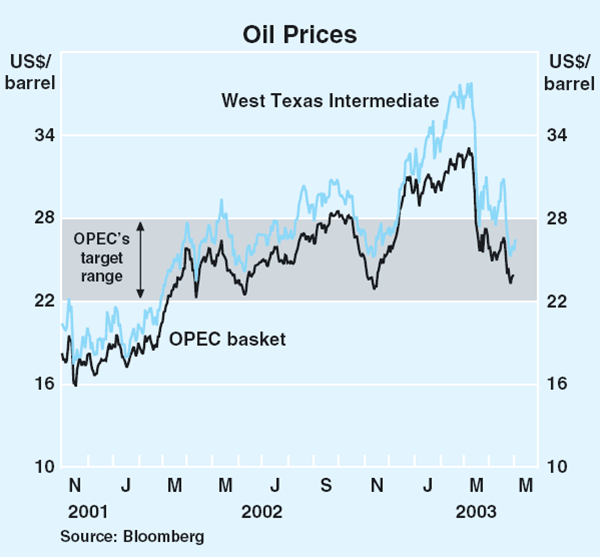
The sharp fall in prices in mid March occurred just before the start of military action in Iraq. The relatively low level of prices since then reflects a combination of limited damage to Iraq's oil-production infrastructure, the resumption of production in Venezuela to near pre-strike levels and milder weather in the US. Moreover, Saudi Arabia has increased production recently, to some extent offsetting the pause in Iraqi oil exports. In late April, OPEC members announced increased quotas and smaller-than-expected cuts in production, effective 1 June, resulting in a further fall in prices. Box A on ‘Global Oil Supply and Capacity’ provides more information on the current and longer-term supply-demand balance in the world oil market.
United States
The US economy has yet to show signs of a sustained pick-up in activity following the loss of momentum towards the end of last year. GDP recorded an increase of 0.4 per cent in the March quarter to be 2.1 per cent higher than a year earlier (Graph 2). In the quarter, there was strong growth of residential construction but consumption growth remained weak and business investment fell (Table 2). Both exports and imports declined in the quarter. The trade deficit, expressed as a ratio to GDP, was unchanged at 4.5 per cent.
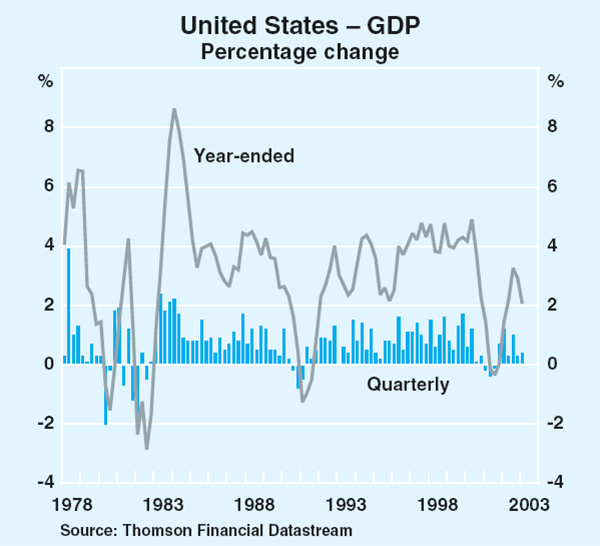
| December quarter 2002 |
March quarter 2003 |
Year to March 2003 |
|
|---|---|---|---|
| Private consumption | 0.4 | 0.3 | 2.3 |
| Residential investment | 2.3 | 2.9 | 6.2 |
| Business investment | 0.6 | −1.1 | −1.3 |
| Public expenditure | 1.1 | 0.2 | 2.4 |
| Change in inventories(a) | 0.1 | −0.1 | 0.4 |
| Net exports(a) | −0.5 | 0.3 | −0.7 |
| – Exports | −1.5 | −0.8 | 2.2 |
| – Imports | 1.8 | −2.0 | 5.7 |
| GDP | 0.3 | 0.4 | 2.1 |
|
(a) Contribution to GDP growth Source: Thomson Financial Datastream |
|||
The weakness in household consumption growth during the March quarter was consistent with some weakening in the labour market. Employment has fallen in recent months, with the unemployment rate rising back to 6 per cent in April, although there was a pick-up in growth in the employment cost index in the March quarter. The sharp rise in oil prices is also likely to have constrained spending for much of the quarter, while the uncertainty surrounding the war in Iraq affected sentiment, which fell to its lowest level in nine years in March before rising sharply in April (Graph 3).
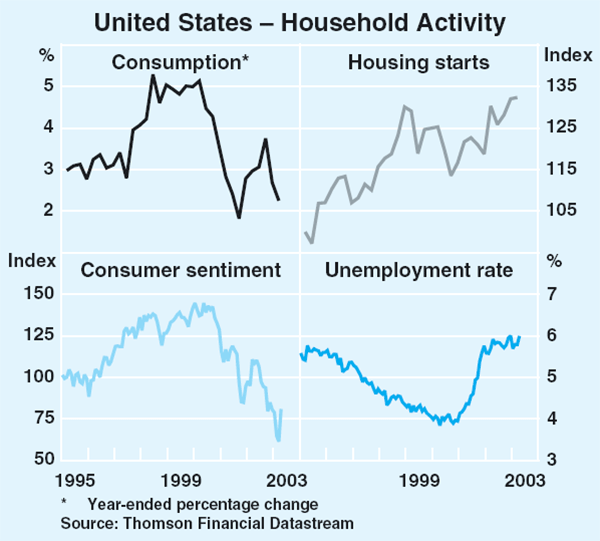
Residential building activity, on the other hand, has continued to be boosted by historically low mortgage interest rates and increasing house prices. Leading indicators such as housing starts and permits remain at high levels, despite a fall in permits of late, suggesting growth in this sector should be sustained in coming quarters. Mortgage refinancing activity was also very strong in the quarter, reaching a new high in early March. Some of this refinancing has helped support consumption.
Manufacturing output has continued to fall in 2003 and, despite rising through the first half of 2002, is now 7 per cent lower than in mid 2000 (Graph 4). Capacity utilisation in March was at its lowest level since 1983. Sentiment, as recorded by the ISM survey, more than retraced the increases recorded in late 2002 to be at its lowest level for over a year, suggesting there may be further weakness in manufacturing output in the near term. Business investment declined in the March quarter with expenditure on equipment falling, after having picked up a little through most of 2002, and expenditure on structures falling further. One positive sign is that new orders of capital goods (excluding defence and aircraft) picked up.
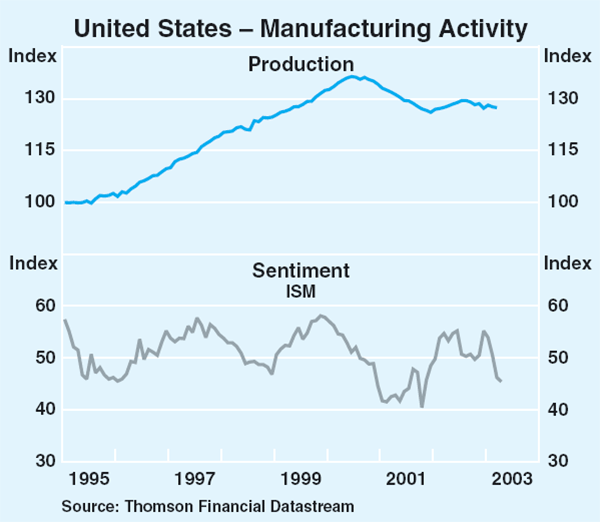
The discretionary fiscal stimulus for 2003 as a whole is likely to be a little larger than expected several months ago. Congress may reject certain measures included in the fiscal package announced in January but has approved a request from President Bush for US$79 billion (¾ of a percentage point of GDP), mostly to fund operations in Iraq.
Largely because of the rise in energy costs, consumer price inflation has increased further in the past few months, to 3 per cent over the year to March. However, the core measure of inflation has edged down to 1¾ per cent, with core services inflation moderating a little to be just over 3 per cent over the year to March and core goods prices continuing to fall by around 1½ per cent in year-ended terms.
Asia-Pacific
Japan
It is unclear whether the growth recorded in Japanese GDP over 2002 has been sustained. Exports, while volatile month to month, have been essentially unchanged since the middle of 2002, with stronger exports to Asia, particularly exports of machinery and equipment to China, recently offset by weaker exports to the US. Consistent with the flat trend in exports, industrial production has gained little ground in the past nine months or so, after picking up in the first half of 2002 (Graph 5). There are, however, some signs of modest improvement in other indicators of manufacturing sector activity: machinery orders data have been stronger in recent months; operating profits increased solidly over the year to the December quarter; and business sentiment, as reported in the Tankan survey, has improved further. In contrast, the non-manufacturing components of these measures have shown little improvement over the past year, consistent with the Tertiary Activity Index, which has remained broadly unchanged.
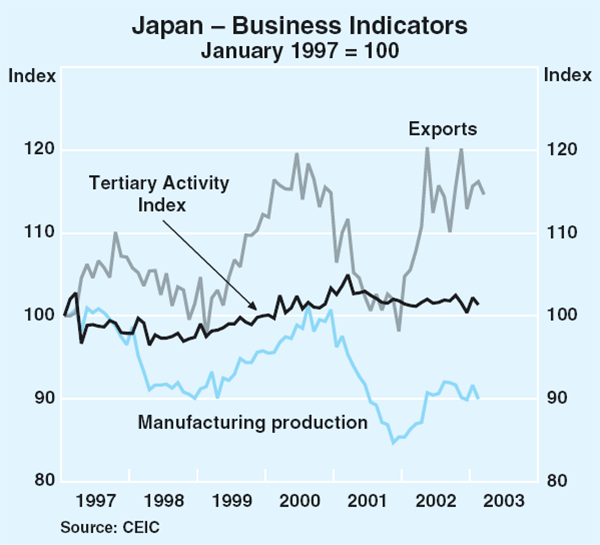
The labour market also has remained weak. Despite increasing in the past couple of months, employment has been broadly unchanged over the past year, with increases in services employment largely offset by declines in the manufacturing sector. The unemployment rate has been between 5¼ and 5½ per cent for most of the past 18 months. On a somewhat brighter note, and consistent with some of the partial indicators for manufacturing noted above, there has been a substantial improvement in manufacturing hours worked, overtime paid and bonuses over the past year.
The Japanese economy continues to experience deflation. Reflecting higher prices for fresh food and petroleum products, the CPI fell by only 0.1 per cent over the year to March, compared with a fall of 1 per cent over the previous year. Excluding these items, inflation has remained around −¾ per cent in year-ended terms.
Non-Japan Asia
The economies of non-Japan Asia on the whole have continued to perform well, with the two largest economies, China and Korea, recording particularly strong growth (Table 3). The strength in China and Korea has been supported by domestic demand as well as exports, with demand in China in particular helping to boost exports from other east-Asian countries. Capital spending has been solid in China and picked up again in Korea, following some construction-induced weakness in the middle of last year. Korean household consumption, which had been boosted by rapid growth in house prices and indebtedness, appears to have moderated in the new year following a government-directed tightening in lending criteria late last year.
| September quarter 2002 |
December quarter 2002 |
Year to December 2002 |
|
|---|---|---|---|
| China | – | – | 9.9(a) |
| Hong Kong | 1.9 | 1.7 | 5.0 |
| India | 1.9 | −1.6 | 2.6 |
| Indonesia | 1.0 | −0.1 | 3.7 |
| Korea | 1.0 | 2.0 | 6.3 |
| Malaysia | 1.7 | 0.7 | 5.5 |
| Philippines | −0.1 | 3.0 | 5.8 |
| Singapore | −1.7 | 0.1 | 3.0 |
| Taiwan | 0.6 | 1.1 | 4.2 |
| Thailand | 1.2 | 2.0 | 6.3 |
|
(a) Year to March 2003 Source: CEIC |
|||
There have been some differences in performance in other parts of the region, largely reflecting differences in trade performance. In particular, growth in Indonesia has slowed following a sharp fall in tourism in the aftermath of the Bali bomb attacks, while the strength of output in Hong Kong in the second half of 2002 was driven by a large pick-up in tourism and other trade-related services. While more recent data suggest industrial production and merchandise exports have continued to hold up in aggregate (Graph 6), the recent outbreak of SARS is likely to dampen activity, particularly in Hong Kong and Singapore, both of which have responded with fiscal measures, and has affected travel and confidence more generally across the region. While China has experienced the largest number of SARS cases, tourism and other service industries account for a smaller share of China's economy than elsewhere in the region.
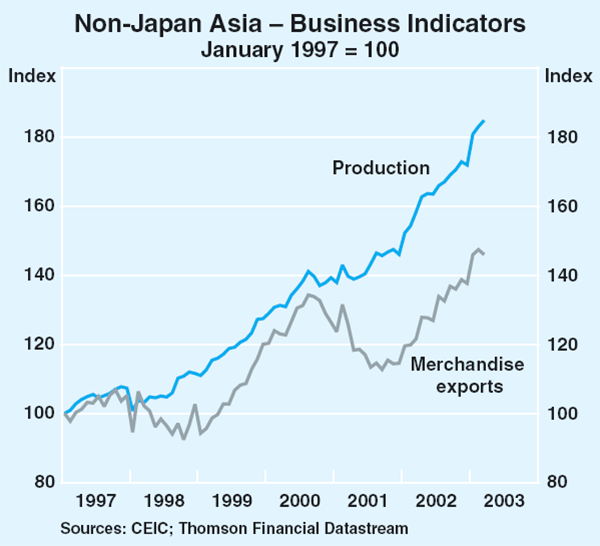
Despite higher oil prices, consumer price inflation in most of the region's countries has eased in recent months and prices continue to decline in Hong Kong. In contrast, year-ended inflation has returned to positive territory in China and, abstracting from food and energy prices, has remained around 3 per cent in Korea.
In New Zealand, output recorded another strong increase in the December quarter, to be 4.5 per cent higher than a year earlier. Private consumption and business investment rose strongly in the quarter, partly offset by a large increase in imports. Although the labour market remains tight, with the unemployment rate around record lows, year-ended inflation fell to 2.5 per cent in the March quarter, after being around the top of the Reserve Bank of New Zealand's target of 1–3 per cent for about a year. Citing a more recent slowing in growth and an easing in inflationary pressures, the central bank cut its key policy rate by 25 basis points in late April.
Europe
There has been little growth in the euro area economy since mid 2002. GDP expanded only slightly in the December quarter, with output in the services sector rising modestly and output in the manufacturing and construction sectors falling. More recently, industrial production has remained flat and business confidence has fallen further (Graph 7). Weakness has been particularly apparent in Germany, with the IFO measure of industrial confidence weaker than sentiment indicators in other countries, while the construction sector has continued its protracted downward trend.
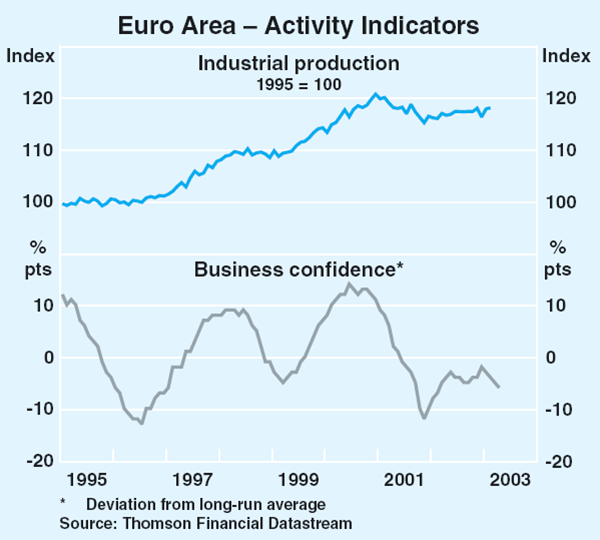
Euro area household consumption continued to expand in the December quarter, with retail trade holding up fairly well in the new year, despite a deterioration in the labour market. The euro area unemployment rate rose to 8.7 per cent in March. Employment continues to fall in Germany and to record little growth in France and Italy. Consumer confidence has also fallen further, to be around nine-year lows.
Euro area inflation was only slightly above the ECB's reference rate, at 2.1 per cent over the year to April, and core inflation has fallen a little further (Graph 8). The easing in underlying inflationary pressures, associated with continued weakness in activity, combined with downward revisions of its forecasts for euro area growth, led the ECB to cut its key policy rate by 25 basis points to 2½ per cent in March. On the fiscal front, the European Commission has begun the ‘excessive deficit’ procedure for France, after its 2002 budget deficit exceeded the 3 per cent of GDP ceiling prescribed by the Stability and Growth Pact. However, France has stated its intention to proceed with planned tax cuts rather than commit to bringing the deficit below 3 per cent of GDP within two years.
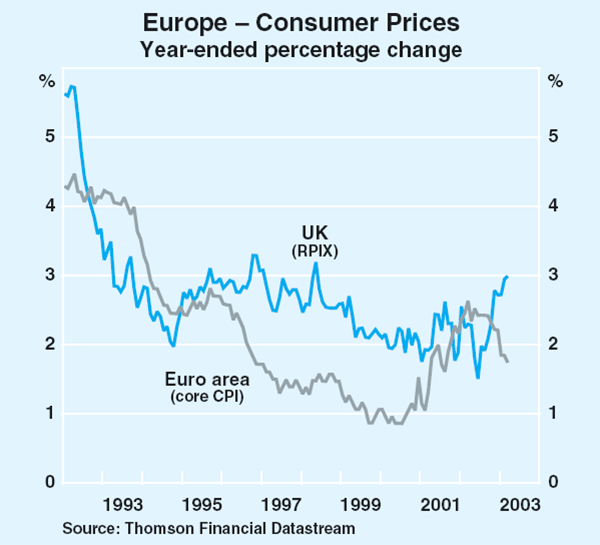
Conditions in the United Kingdom remain a little stronger than elsewhere in Europe despite growth slowing further in the first quarter of 2003. Services sector output weakened, following several years of solid expansion, and industrial output remained subdued. Despite a strong labour market – the unemployment rate is around historic lows – and increased household borrowing against rising house values, retail sales rose by only 0.1 per cent in the quarter.
Although year-ended inflation (excluding mortgage costs) has remained around the top of the Bank of England's target range, forecasts for a weaker outlook and lower inflation prompted the Bank of England to reduce its policy rate by 25 basis points in February to 3¾ per cent. The fiscal deficit is expected to remain around 2½ per cent of GDP this year before decreasing by around ¼ of a percentage point next year.
Box A: Global Oil Supply and Capacity
Crude oil prices have shown considerable volatility of late, reflecting uncertainties about the conflict in Iraq and the extent of any disruption to oil production in the region. This box outlines the importance of the Middle East in global supply.
Around 40 per cent of the world's crude oil production comes from Organisation of Petroleum Exporting Countries (OPEC)[1], the bulk of which is from countries in the Middle East. Saudi Arabia is the world's largest producer, accounting for nearly 12 per cent of total output in 2001, closely followed by Russia (10 per cent) and the United States (9 per cent). These shares have been reasonably steady over the past few years, following the large decline in oil production in Russia in the early 1990s. The remaining 70 per cent of the world's crude oil production is distributed fairly evenly across the main geographic regions though, apart from the Middle East, it is concentrated in a few countries in each region.
OPEC members' share of world crude oil exports is significantly larger than their share of production, reflecting the degree to which other oil producers consume their own product. Saudi Arabia is by far the largest exporter of crude oil, accounting for 16 per cent of total exports in 2000; the remaining OPEC members accounted for 38 per cent of exports (Graph A1). Exports from Iraq, which were suspended in mid March 2003, accounted for 5 per cent of total exports in 2000.
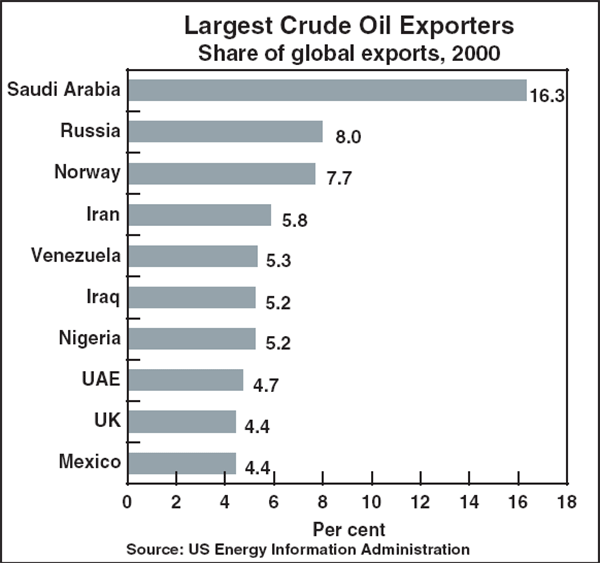
The United States is the world's largest consumer of oil, with a little less than half of its consumption met from domestic production (Table A1). China was self-sufficient in oil until 1993 but rapid growth in domestic demand resulted in production accounting for less than 70 per cent of consumption by 2000. Other large oil consumers such as Japan, Germany and South Korea rely on imports for almost all of their consumption. In aggregate, Australia's consumption of oil is roughly matched by output but there are some imbalances between the types of oil produced and consumed, and hence Australia both imports and exports oil.
| Australia | 94 |
|---|---|
| Canada | 132 |
| China | 68 |
| Germany | 5 |
| Japan | 1 |
| Russia | 260 |
| Saudi Arabia | 642 |
| South Korea | 3 |
| United Kingdom | 148 |
| United States | 46 |
|
Note: Oil includes crude oil, natural gas plant liquids, other liquids, and refinery processing gain. Source: US Energy Information Administration, 2000 |
|
Industrialised countries' inventories of oil are typically lower than a year ago, despite an increase in the US Government's Strategic Petroleum Reserve. More fundamentally, however, these countries have generally been quite successful in reducing their dependence on oil since the early 1970s. (For more details, see Box A in the November 2000 Statement on Monetary Policy.)
As well as being major producers of crude oil, OPEC members account for almost all of the world's current spare capacity (which can be accessed in a short period of time). Moreover, OPEC members currently account for around two-thirds of proven oil reserves, although their share has fallen from around 80 per cent last year following the new-found viability of oil sands in Canada (Graph A2). Saudi Arabia possesses the largest share of proven reserves, accounting for just over one-fifth of global reserves.
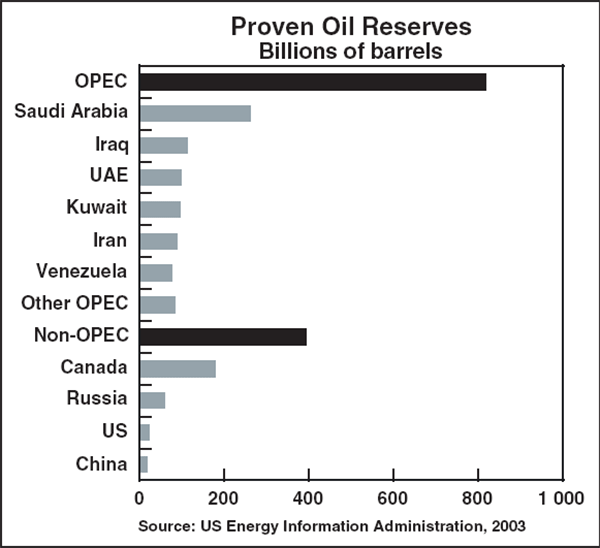
International and Foreign Exchange Markets
Developments in international financial markets during the past three months mainly reflected the ebb and flow of news about Iraq. Early in the period, markets exhibited increased risk aversion as international tension grew. Key elements included a switch from equity investments to bonds, a move out of US dollars, particularly into currencies such as the Swiss franc which have a ‘safe haven’ reputation, and speculative buying of gold and oil. One important consideration weighing on markets was the likelihood that the sharp increase in oil prices had significantly increased the downside risks to economic growth. These trends gathered momentum through February and into March. By mid March, however, sentiment had swung to the view that the impending war would be over relatively quickly and these trends were sharply reversed.
Markets paid less attention than usual to economic data through this period, though once the war was over the general assessment seemed to be that the data in the major regions of the world, with the possible exception of non-Japan Asia, had mostly been disappointing. As such, even though markets are no longer exhibiting the extreme pessimism seen in early March, they do not as yet show much conviction that a pick-up in world economic growth is occurring. Abstracting from the volatility during the periods of heightened uncertainty, bond yields and share prices in most industrial countries have been on a generally flat trend over the past six or so months and remain lower than their levels of a year ago.
Short-term interest rates
The economic noise generated by the events of recent months has made it more difficult to read the underlying economic trends. The US Fed has responded to this by keeping its policy rate unchanged at 1.25 per cent. This is the lowest level since the early 1960s. While the Fed did not present a policy bias following the meeting of the Federal Open Market Committee in March, saying that it could not usefully characterise the balance of risks, markets expect the Fed to ease monetary policy again. The Fed funds futures market is currently pricing in a 25 basis point easing in the second half of the year (Graph 9).
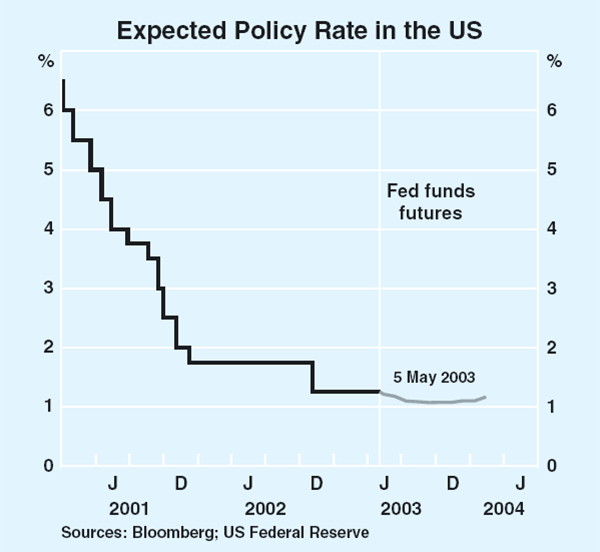
In Europe, where signs of economic weakness have recently been more pronounced than in the US, a number of European central banks have eased monetary policy (Graph 10, Table 4). The European Central Bank in March cut rates by a further 25 basis points to 2½ per cent, a level which, apart from a brief period in 1999, is the lowest in the post-World War II period. Market participants expect a further easing in coming months, with futures markets pricing in a 25 basis point cut by June.
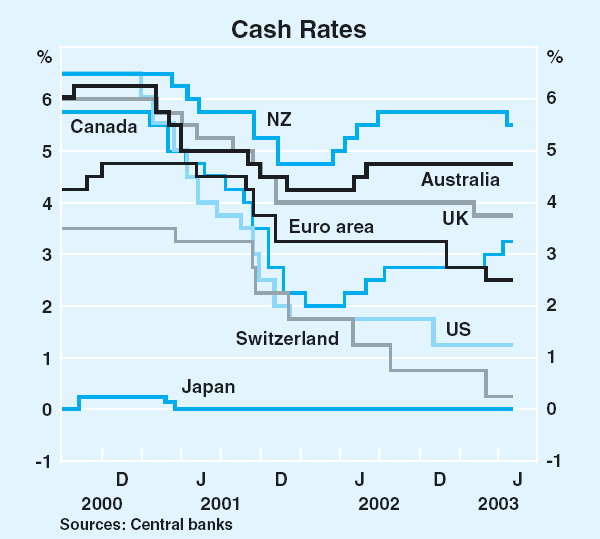
| Current level Per cent |
Cumulative reductions in easing cycle through to early 2002 Basis points |
Subsequent moves Basis points | ||
|---|---|---|---|---|
| Up to September 2002 |
October 2002 to April 2003 |
|||
| US | 1.25 | −475 | −50 | |
| Euro area | 2.50 | −150 | −75 | |
| Japan | 0.00 | −25 | ||
| UK | 3.75 | −200 | −25 | |
| Canada | 3.25 | −375 | 75 | 50 |
| Switzerland | 0.25 | −175 | −100 | −50 |
| Sweden | 3.50 | −50 | 50 | −75 |
| Norway | 5.00 | −50 | 50 | −200 |
| Australia | 4.75 | −200 | 50 | |
| NZ | 5.50 | −175 | 100 | −25 |
|
Sources: Central banks |
||||
In the UK, the Bank of England surprised financial markets in February when it cut its policy rate by 25 basis points to 3.75 per cent. Since then it has kept rates on hold, although futures markets continue to price in a further 25 basis points of easing by June. The policy rate in the UK is now at its lowest level since the late 1950s.
The central banks of Switzerland, Norway, Sweden and Denmark have also eased monetary policy in recent months. Concern about the growth outlook for the world economy, and particularly the euro area, was cited as a major reason for the reductions, though in the case of the Swiss central bank, the strength of the Swiss franc was also an important factor.
The Reserve Bank of New Zealand reduced its official cash rate by 25 basis points to 5.5 per cent in April.
In Japan, the central bank has maintained the cash rate at zero and has announced further measures to try to stimulate monetary expansion. These include an increase in the amount of share purchases it intends to undertake from banks, from JPY2 trillion to JPY3 trillion, and the planned purchase of asset-backed securities. Also, the target range for bank reserves was increased further in April.
The only industrial country increasing interest rates is Canada. The Bank of Canada raised its policy interest rate by a further 50 basis points to 3.25 per cent in two steps over March and April, citing persistent above-target inflation and strong final domestic demand. These follow tightenings totalling 75 points in 2002. After the US, Canada had undertaken the largest easings during 2001, which had left it with an unusually low level of interest rates. The subsequent tightenings have reversed only part of the earlier easing.
Interest rates have been broadly stable at low levels in Asian emerging markets. The exception was Indonesia, which lowered rates by a total of just over one percentage point, to 11 per cent, reflecting lower inflation outcomes in recent months. In Latin America, official interest rates have generally remained unchanged.
Long-term interest rates
The Iraq war was the main influence on bond yields in most industrial countries over the past three months. As noted, the build-up to the war saw rising risk aversion in financial markets, resulting in increased demand for government bonds which caused their yields to fall (Graph 11). Once it became clear that the war was likely to be over quickly, bond yields rose again.
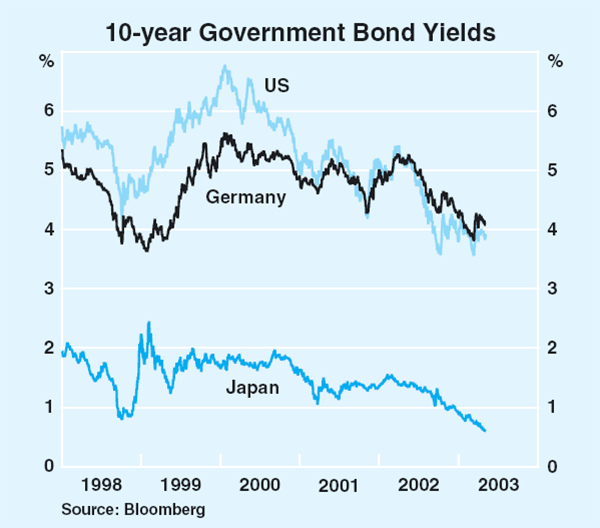
While most countries experienced this cycle in bond yields, its severity varied. In the US, yields on US 10-year government debt fell by around 40 basis points in the run-up to the war, to a 45 year low of 3.56 per cent. All this move has since been reversed and yields are now much the same as they were early in 2003. This remains a low level by historical standards.
In Europe, the cycle in bond yields caused by the war was less pronounced than in the US, but overlaid on this has been a downward trend in yields as disappointment about economic growth in Europe has been more marked than in the US. Bond yields in Europe are now 40 basis points lower than they were six months ago, though they are still above comparable yields in the US.
Japanese bond yields experienced very little ‘war’ impact and the dominant influence seemed to be pessimism about the Japanese economy and the Japanese share market. Even though yields were already at unprecedented lows at the start of the year, they have since fallen noticeably further. Ten-year yields are currently 0.6 per cent, down from 1.0 per cent six months ago and 1.4 per cent a year ago.
Spreads on US corporate debt to US Treasuries have continued to narrow over recent months (Graph 12). The easing was noticeable across all credit ratings with ‘junk’ bond spreads falling by 140 basis points over the past three months, and AAA spreads narrowing by 40 basis points. Spreads had risen to very high levels in the second half of 2002 due to the extreme uncertainty associated with a number of high profile corporate collapses in the US. This has now been fully reversed.
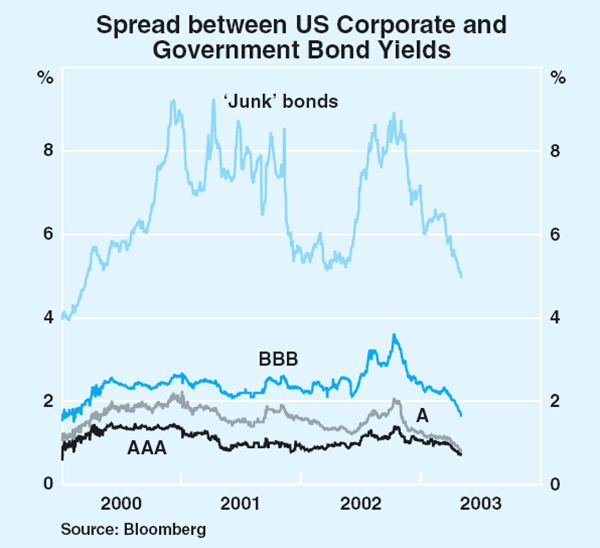
Spreads on emerging market sovereign debt have narrowed by around 150 basis points over the past three months, reflecting continued improvement in perceptions of sovereign risk in both Latin America and emerging Europe (Graph 13). In particular, Brazilian spreads have fallen by 500 basis points to around 10½ per cent. Spreads on Asian emerging market sovereign debt, which are at much lower levels than in other emerging markets, showed little net change.
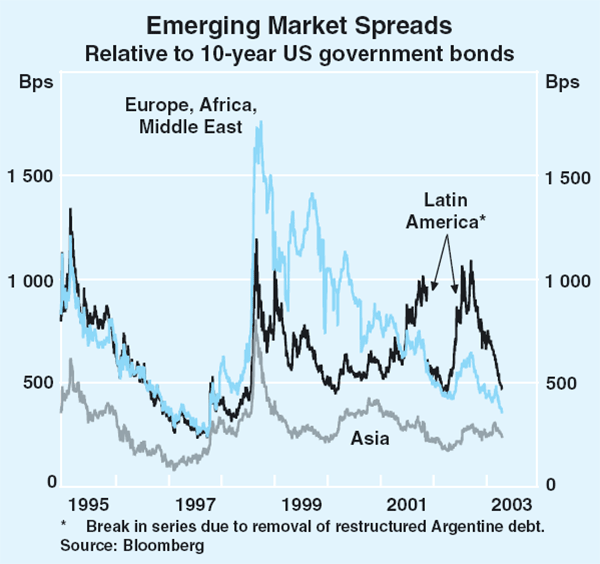
Equity markets
The pattern in equity markets was fairly consistent with that in bond markets, again reflecting the importance of war news. Broad measures of US share prices fell by 6½ per cent over February and early March, but have since rebounded strongly to be 5 per cent higher than at the start of the year (Graph 14). US corporates have generally announced stronger-than-expected March quarter earnings, which has helped to support the share market in recent weeks. On the other hand, the underfunding of company pension schemes remains a major issue which still needs to be resolved and could be a significant drag on profits in the period ahead. Also, the US financial accounts data show that over the past two years the non-financial corporate sector has been paying out more in dividends than it has earned in profits, reducing internal funds which would otherwise have been available for investment (Graph 15).
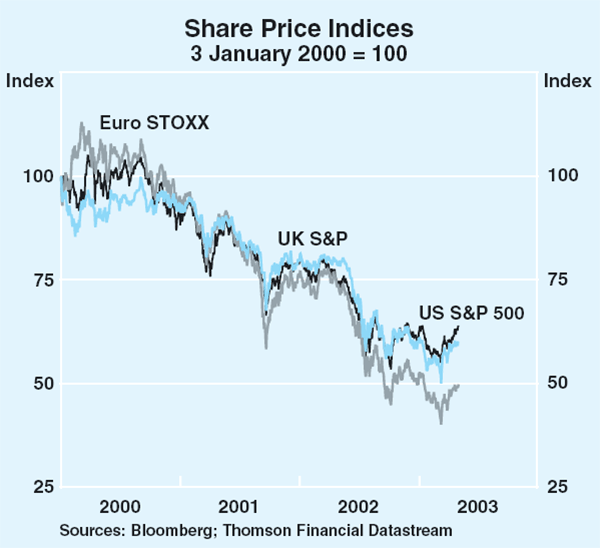
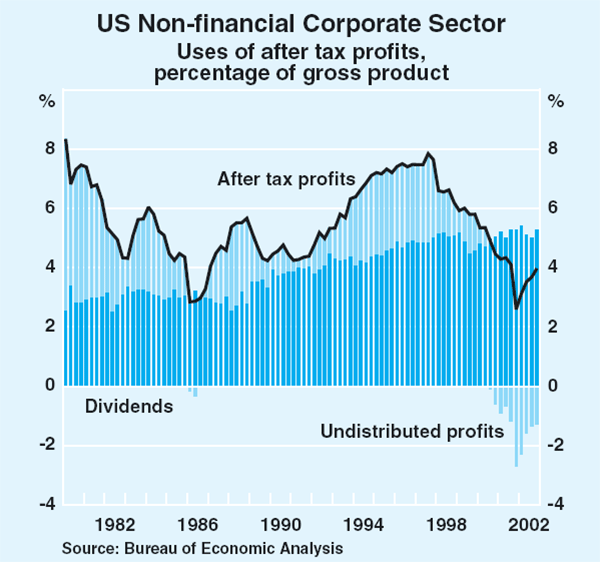
European equity markets have also taken their lead from events in Iraq recently, though they have generally underperformed the US market (Table 5). Since the middle of 2002, the Euro STOXX and UK S&P indices have fallen by 23 and 15 per cent respectively, compared with a fall of 6 per cent for the US S&P 500. The major driver of this underperformance has been the financial sector, with the Euro STOXX and UK S&P financial sub-indices falling by 26 and 18 per cent respectively since June 2002, compared with a fall of 6 per cent in the comparable sub-index for the US. Within the financial sector the insurance sector has performed particularly poorly in Europe. This mainly reflects the high proportion of investments held in equities by insurance companies in the euro area and the UK, as well as the proliferation of life insurance policies with guaranteed returns. More generally, insurance companies worldwide have experienced large losses associated with an increase in asbestosis claims and claims associated with directors' liabilities. During the second half of the 1990s some of the credit risk on bank balance sheets was also transferred to insurance companies (mainly via credit derivatives). A longer-term perspective on international equity markets is given in Box B.
| Since 2000 peak |
Over 2001 |
Over 2002 |
2003 to date |
|
|---|---|---|---|---|
| United States | ||||
| – Wilshire | −40 | −12 | −22 | 6 |
| – Dow Jones | −27 | −7 | −17 | 2 |
| – S&P 500 | −39 | −13 | −23 | 5 |
| – NASDAQ | −70 | −21 | −32 | 13 |
| Euro area | ||||
| – STOXX | −56 | −20 | −35 | 0 |
| United Kingdom | ||||
| – FTSE | −43 | −16 | −24 | 0 |
| Japan | ||||
| – TOPIX | −54 | −20 | −18 | −5 |
| Canada | ||||
| – TSE 300 | −42 | −14 | −14 | 1 |
|
Source: Bloomberg |
||||
Japanese equity prices were relatively unaffected by global events. While the broad-based Japanese indices fell over February and early March, they did not benefit from the rebound seen in the other major markets over the second half of March. Indeed the Topix index fell to a 19-year low in April. The declines resulted in a range of official proposals being mooted to support stocks, although the proposals are yet to be finalised. The Bank of Japan continued its stock purchase program from banks, and by late April had purchased around JPY1.2 trillion in shares. As noted previously, the ceiling on total stock purchases was raised to JPY3 trillion from JPY2 trillion in March.
Asian equity markets have generally fallen since the end of January owing first to uncertainty about the world economic outlook and more recently to fears regarding the economic impact of the SARS virus. The largest declines were experienced in Taiwan (16 per cent), China (7 per cent) and Malaysia (5 per cent). In contrast to Asia, Latin American markets rose by between 10 and 20 per cent over the past three months, with the exception of Venezuela which remains affected by political turmoil.
Exchange rates
The build-up to war added to the move out of US dollars and the trade-weighted value of the US dollar fell by 3 per cent over February into early March, reaching a new three-year low (Graphs 16 and 17). There was a brief respite when it became clear that the coalition forces would achieve a quick and decisive victory, but by mid April the market was again selling the dollar. In trend terms, the US dollar has moved sideways against the Japanese yen over much of the past year, but against the euro it has fallen by about 24 per cent since early 2002.
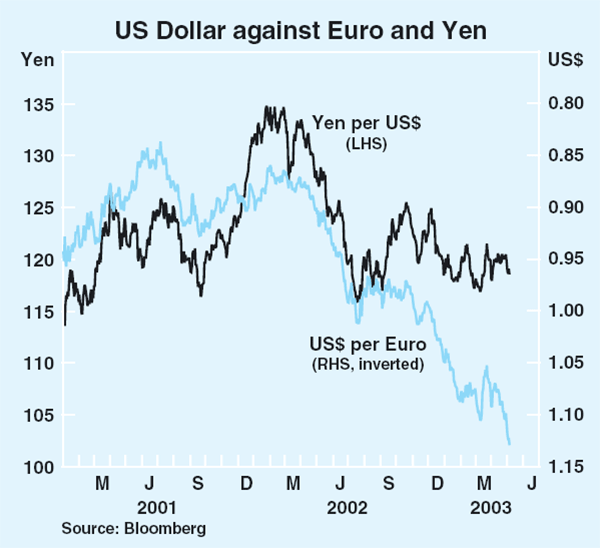
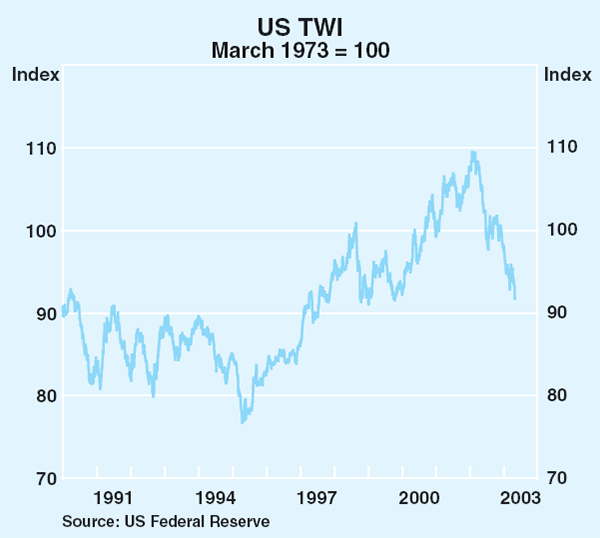
Other European currencies have generally also risen against the US dollar, particularly the Swiss franc which experienced strong ‘safe haven’ demand for a time. The UK pound has largely gone down with the US dollar recently, the downward move being particularly pronounced after the Bank of England surprised markets with a rate cut in February.
Asian currencies were broadly steady against the US dollar over recent months, maintaining the sideways trend which has prevailed since early 2001. Latin American currencies generally appreciated against the US dollar, with the Argentinean and Brazilian currencies rising by nearly 20 per cent. Following a 30 per cent fall in the currency over January, Venezuela fixed the bolivar against the US dollar.
Australian dollar
The Australian dollar has continued to recover in recent months from the unusually low levels to which it fell in 2001. At the end of that year, the exchange rate against the US dollar was around US51 cents. By the end of 2002, it had risen to about US56 cents; and in 2003 to date it has risen to over US63 cents.
Just as the unusually low exchange rate against the US dollar in 2001 was to a large degree a reflection of the US dollar's strength at that time, the subsequent rise of the Australian dollar has in large part reflected the US dollar's fall over the past year or so. For example, even though the Australian dollar has risen by over 20 per cent against the US dollar since the end of 2001, it has fallen against most European currencies over the same period – the notable exception being the British pound. Accordingly, the trade-weighted index of the Australian dollar has risen less than the rate against the US dollar (Graph 18). The increase nonetheless has been substantial, partly because the Asian currencies, which have quite a high weight in the index, have slipped against the Australian dollar over the past year or so, as they tend to follow (or be directly linked to) the US dollar. Since the end of 2001, the TWI is up by about 13 per cent, of which about 10 per cent has occurred in 2003 (Graph 19). Despite this rise, the current level of the TWI is only broadly in line with its post-float average. The exchange rate against the US dollar, of course, remains well below its long-run average.
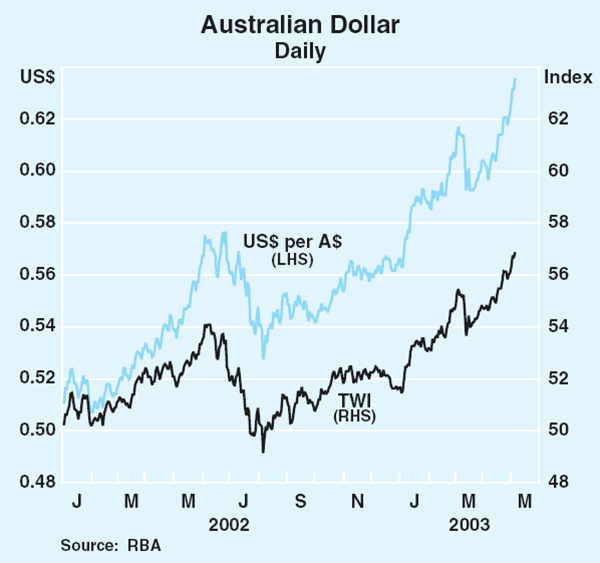
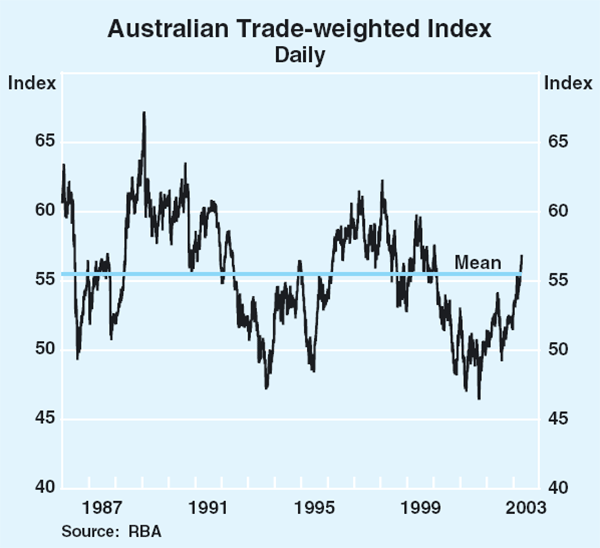
As in the case of equity and bond markets, there has been some volatility in the foreign exchange market in recent months due to the war. The Australian dollar rose strongly in late February and early March as part of a general move away from the US dollar, but this was reversed in mid March as the US dollar recovered. Since then, the downward trend in the US dollar and the upward trend in the Australian dollar have resumed. The Australian dollar's exchange rate against the euro has remained in a tight range through most of 2003, around 0.56 euros.
One of the factors supporting the Australian dollar has been strong overseas demand for Australian dollar bonds, particularly by Japanese retail investors. This overseas demand reflects relatively attractive interest rates and, related to that, a stable and well-performing economy. Australian dollar eurobond issuance averaged $4.4 billion a month in the first four months of this year, compared with a monthly average of just under $2 billion in 2002 and less than $1 billion in earlier years. Uridashi issuance, which refers to bonds issued into the Japanese retail market, has accounted for much of the increased interest although market participants report robust demand for Australian dollar denominated debt from investors in Europe and non-Japan Asia. (See chapter on ‘Domestic Financial Markets’ for more detail on bond issuance.)
Another supportive factor has been an upgrade of Australia's foreign currency debt ratings to AAA by Standard and Poor's in February. Australia now has a AAA rating from both Moody's and S&P (Moody's lifted its rating for Australia to AAA in October last year). Fitch also raised its sovereign foreign currency rating for Australia in February, though only from AA to AA+. The upgrades reflect Australia's sound financial position, including its strong public finances and an absence of foreign currency exposure on external finances, as foreign debt is largely hedged to Australian dollars.
The RBA continued to rebuild its foreign currency reserves by making market purchases over the past few months which more than covered the Government's requirements. In the three months to April, net purchases amounted to around $480 million, while earnings on foreign reserves added some $360 million. Valuation effects, however, reduced reserves by $990 million. Current net reserves stand at around $12 billion, up $4 billion from a year ago. The Bank also made substantial use of foreign exchange swaps during the past few months to manage domestic liquidity. The swap position has fluctuated in a $5 billion range in 2003, though in net terms it has shown little change, and currently stands at around $26 billion. Total reserve holdings (i.e. reserves held outright plus reserves held under swap agreements) currently total $37 billion.
Box B: Global Equity Markets
March 2003 marked the third anniversary of the peak in global equity prices. Since then equity price indices in all the major countries have fallen significantly.
In the case of the US share market, prices have fallen by around 40 per cent from their peak in March 2000, though they are still around 45 per cent higher than in the mid 1990s. This fall is the largest retracement since the Great Depression of the early 1930s, when nominal prices fell by over 80 per cent. The most recent comparable nominal correction occurred in 1973–74 when the US S&P also fell by just over 40 per cent (Graph B1).
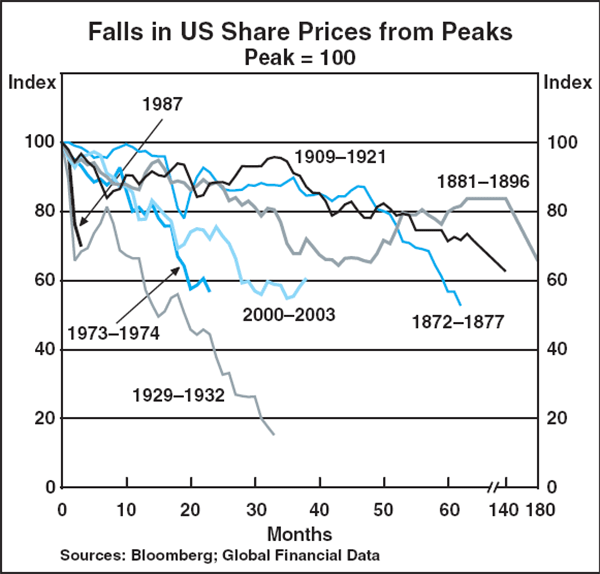
The current bear market is only the fifth time since 1870 that broad measures of US share prices have fallen for three or more consecutive calendar years. The market has only once fallen for four years in a row (1929–1932).
While the recent fall in US share prices has been large, the slump in most other major markets has been even more pronounced (Graph B2). In most European countries, share prices have fallen by between 50 and 70 per cent since their peak. However, these share markets also generally experienced the largest increases in the second half of the 1990s (Table B1).
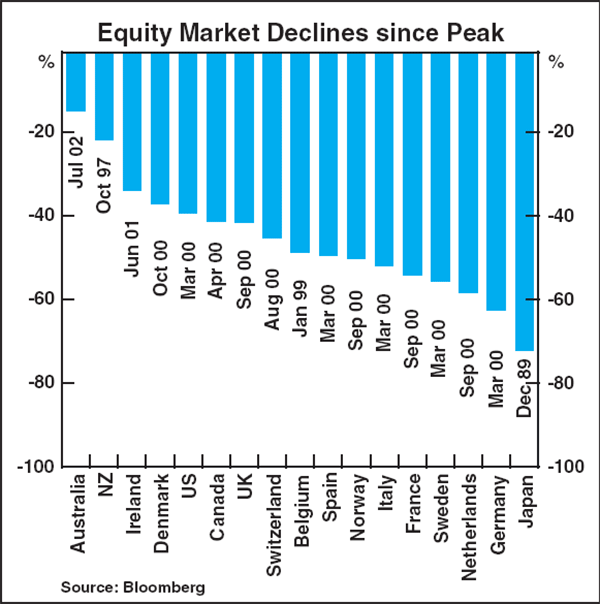
| Dec qtr 1995– Mar qtr 2000 |
Mar qtr 2000– Mar qtr 2003 |
Dec qtr 1995– Mar qtr 2003 |
|
|---|---|---|---|
| US S&P 500 | 138 | −39 | 44 |
| Euro STOXX | 223 | −55 | 45 |
| German Dax | 236 | −64 | 21 |
| UK FTSE | 79 | −42 | 3 |
| Australian ASX 200 | 50 | −7 | 39 |
| Japan Topix | 14 | −50 | −43 |
|
Source: Bloomberg |
|||
In the euro area, share price indices more than tripled over the second half of the1990s. A factor contributing to this surge was the large weight of the financial and telecommunication sectors in European share markets compared with the US. To the extent that the largest increases were recorded in some of the smaller countries, this may also have reflected a build-up of ebullient expectations in Europe ahead of the introduction of the euro, with some of the smaller countries expected to benefit most from the introduction of the single currency. German share prices have been very weak in the latest downturn, owing mainly to the under-performance of German banks and insurance companies.
The experience of the UK has been somewhat different from the rest of Europe. In the UK, the increase in share prices in the second half of the 1990s was modest compared with the rest of Europe and the US. To a large degree this reflected the small number of information technology firms represented in the UK index. The fall in UK share prices since the 2000 peak, however, has been similar in size to that of the US. As a result, share prices in the UK are now only marginally above where they were in the middle of the 1990s.
In Japan, share prices are now down 73 per cent from their peak in December 1989. Even though Japanese share prices had already experienced a large fall by the time the US market started to decline in 2000, they have since fallen by more than the US market.
Domestic Economic Activity
The latest national accounts show that real GDP rose by 0.4 per cent in the December quarter, to be 3 per cent higher over 2002 (Table 6). While the pace of growth slowed from rates seen earlier in the year, this largely reflected developments in the farm sector, with the drought directly subtracting 0.9 percentage points from growth over 2002. Overall, activity continued to be underpinned by strength in domestic demand, which posted a rapid 7 per cent gain over 2002. This strength remained broad-based; while consumption growth eased in the latter stages of 2002, the upswing in business investment gathered pace and housing activity remained strong.
| December quarter 2002 |
Year to December quarter 2002 |
||
|---|---|---|---|
| Private final demand(a) | 2.5 | 7.6 | |
| – Consumption | 0.6 | 4.1 | |
| – Dwelling investment | 4.2 | 20.6 | |
| – Business investment(a) | 10.0 | 19.5 | |
| Public final demand(a) | 2.5 | 4.2 | |
| Domestic final demand | 2.5 | 6.9 | |
| Change in inventories(b) | −0.1 | −0.3 | |
| Exports | −0.4 | 2.1 | |
| Imports | 7.0 | 17.1 | |
| Net exports(b) | −1.7 | −3.3 | |
| Gross domestic product | 0.4 | 3.0 | |
|
(a) Excluding the effect of transfers between the private and other sectors
Source: ABS |
|||
Rapid growth in domestic demand, particularly the import-sensitive machinery and equipment component of investment, underpinned a marked increase in imports. In contrast, export volumes remain constrained by subdued global conditions and drought-induced weakness in rural exports. As a result, net exports subtracted 3.3 percentage points from GDP growth over 2002 (Graph 20).
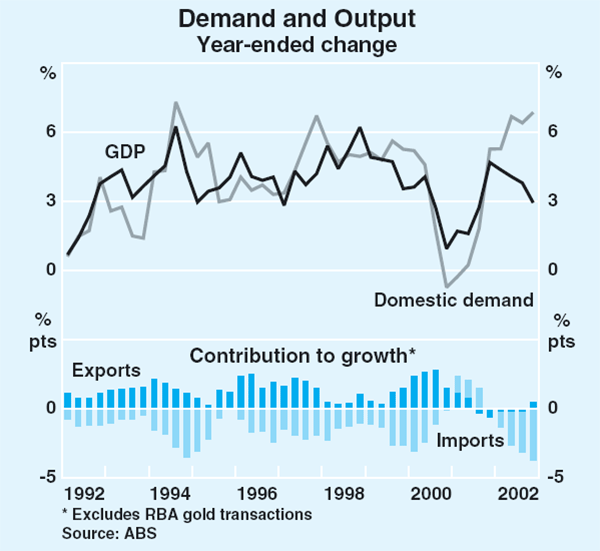
Domestic demand is expected to slow from the rapid pace recorded in 2002 to a more sustainable growth rate during 2003. Forward indicators suggest that dwelling investment has peaked, but at this stage the downturn in this sector is expected to be mild compared with previous cycles. Growth in consumption is expected to be supported by continued employment growth and the recent easing in oil prices. Strength in business investment should continue in the period ahead, with capital expenditure intentions and the amount of work in the pipeline suggesting that the recovery in investment has further to run. However, the effect of the drought will continue to be felt in the next few quarters, with a further fall in farm production projected to reduce GDP by 0.4 percentage points in the first half of 2003.
The household sector
Household consumption grew by 4.1 per cent over the course of 2002, with the very rapid growth in the first half slowing to a more sustainable pace in the second half. Recent indicators suggest that this more moderate pace of consumption growth has continued into the first few months of 2003 (Graph 21). The volume of retail sales, which accounts for more than a third of household consumption, decreased by 0.2 per cent in the March quarter. The easing in growth has been particularly marked in recreational and household goods; the latter suggests that the impetus from buoyant levels of housing activity may be waning. However, motor vehicle sales, which are not included in the retail figures, increased strongly in the quarter.
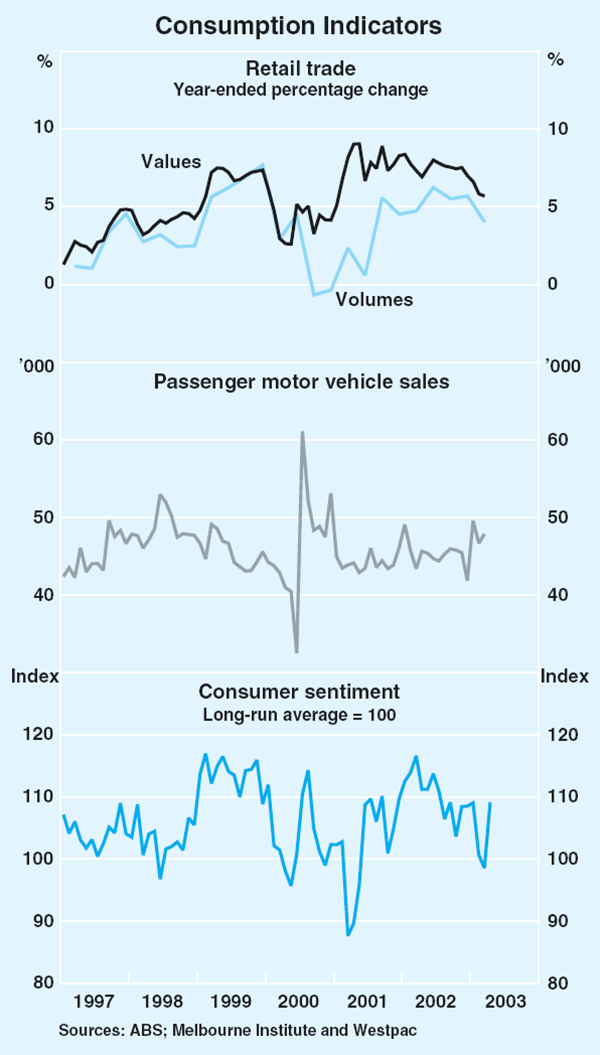
The outlook for consumption remains favourable. Higher wages and strong employment growth have been partly offset by the effects of the drought on farm incomes. Lower farm incomes are likely to persist into mid 2003, despite the easing in drought conditions. Consumer sentiment has been volatile in the past few months, reflecting consumer reactions to events in Iraq and movements in petrol prices, but has returned to above its long-run average. Growth in consumption also continues to be supported by increases in household borrowing and wealth.
The fast pace of household debt accumulation has continued into 2003, increasing by 19½ per cent in annualised terms over the three months to March. The increase in housing-related debt has exceeded net new spending on housing assets, implying that households are continuing to draw on their accumulated equity in the housing stock. The rate of housing equity withdrawal in the December quarter remained at its high level of recent quarters.[1]
The value of household assets has continued to grow strongly, increasing by 15 per cent over the year to the December quarter (Table 7). Most of the growth is explained by strong increases in dwelling prices. The value of household financial assets increased slightly in the December quarter, but remained around 3 per cent lower over the year, mainly reflecting the decline in equity markets. The strong growth in dwelling prices has also meant that a measure of household gearing – the ratio of debt to assets – was roughly unchanged over the year, at close to 15 per cent.
| Level | Share of total | Annual growth Per cent | ||
|---|---|---|---|---|
| $ billion | Per cent | Year to Dec 2002 |
Average Dec 1996– Dec 2001 |
|
| Non-financial assets | 2,391 | 68.8 | 25.4 | 11.3 |
| Financial assets | 1,084 | 31.2 | −2.8 | 10.3 |
| – Superannuation and life offices | 522 | 15.0 | −2.4 | 11.7 |
| – Equities and unit trusts | 210 | 6.0 | −17.4 | 16.3 |
| – Currency and deposits | 313 | 9.0 | 10.0 | 6.5 |
| – Other | 39 | 1.1 | −5.2 | −2.6 |
| Total assets | 3,474 | 100.0 | 15.0 | 11.0 |
|
(a) Non-financial assets comprise consumer durables and dwellings. Financial assets include assets of the unincorporated sector and exclude unfunded superannuation and prepayment of insurance. Sources: ABS; RBA |
||||
The increases in interest rates in the first half of 2002 and rising level of household debt have raised households' debt-servicing requirements (Graph 22). In the December quarter 2002, households' gross interest payments are estimated to have reached 7½ per cent of household disposable income, close to the highs over the past decade. Some aspects of the measurement of aggregate interest payments are discussed in more detail in Box C.
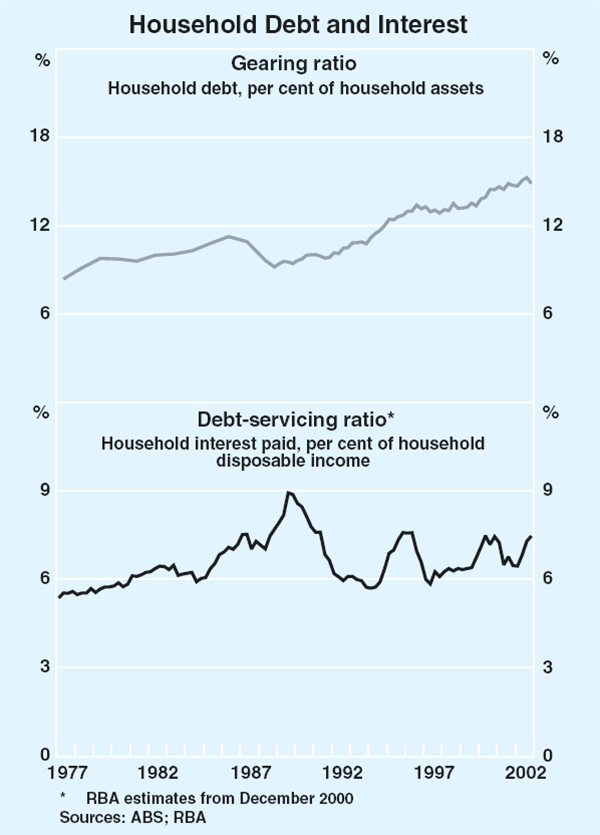
Housing
The upturn in the housing sector continued in the December quarter, with dwelling investment rising by 4.2 per cent in the quarter to be 21 per cent higher over the course of 2002. Construction of new dwellings rose by 28 per cent over the year, while expenditure on alterations and additions was 11 per cent higher. Looking ahead, some easing in housing activity is expected given the downturn in a range of leading indicators, but at this stage the downturn is likely to be smaller than in previous cycles. The large amount of medium-density construction work in the pipeline and ongoing growth in renovation activity should support building activity in the period ahead.
Building approvals for detached houses have been on a downward trend for the past year and a half, and the number of commencements declined in the December quarter (Graph 23). However, builders report that commitments to construct new houses, while down from their recent peak, remain at high levels. The number of loan approvals to owner-occupiers for new construction has risen in recent months although it remains well below its peak.
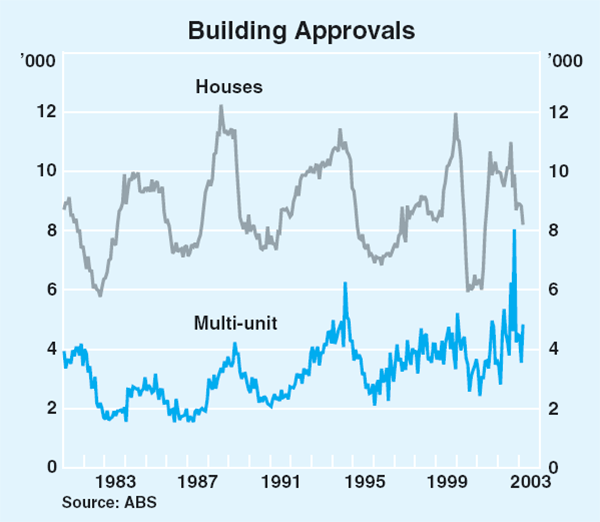
Building approvals in the multi-unit sector, where investor interest predominates, have been at a high level. A large number of apartments remain under construction or committed for construction in the near future. The amount of work yet to be done has risen sharply and, for the first time, significantly exceeds that for detached housing. However, there is anecdotal evidence of a slowing in investor demand in the apartment market and the value of housing loan approvals to investors has levelled out in recent months. Oversupply in the rental market is likely to further dampen investor activity. Rents have been declining in real terms and vacancy rates remain around historically high levels. In recent months there has also been a significant reduction in the number of units planned, particularly in the inner-city apartment markets in Melbourne and Brisbane.
Ongoing growth in renovation activity, boosted by rising dwelling prices and land supply shortages in some cities, may partly offset any decline in new dwelling investment in the period ahead. Expenditure on alterations and additions now accounts for around 40 per cent of overall dwelling investment. Loan approvals for alterations and additions have risen in recent months, and the value of building approvals for this purpose has increased to be more than 10 per cent higher in the March quarter compared with a year earlier.
Other indicators of activity in residential property markets are consistent with some easing in demand pressures. The value of total loan approvals to owner-occupiers, which includes loans for the purchase of existing dwellings, has broadly levelled out over the past year and a half; as noted above, a similar, although much more recent, pattern is apparent in loan approvals to investors (Graph 24). Auction clearance rates in Sydney and Melbourne so far this year have remained below their averages of the first half of 2002. The number of properties being offered for auction has also declined, with the number of properties sold at auction around 20 per cent lower in the first four months of 2003 than a year earlier. Credit extended for housing has continued to grow quite strongly however, largely reflecting the earlier rapid growth in the value of loan approvals.
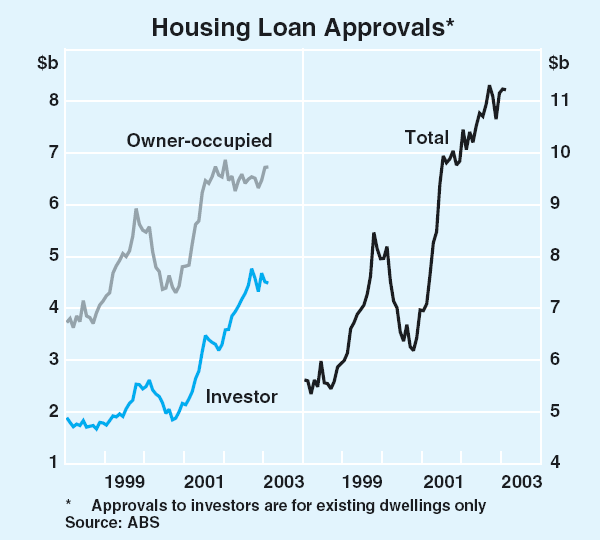
According to most measures, house prices continued to rise strongly in the December quarter 2002, extending the large gains of the previous two years. Within the national average, there was some variation across cities, with price growth in Melbourne clearly slowing in the second half of 2002. More recent indicators have been mixed. Data from the Commonwealth Bank suggest that house prices continued to rise rapidly across mainland Australia over the year to the March quarter, though they declined in Sydney and Canberra in the latest quarter. Unit prices fell in the March quarter, entirely reflecting a sharp fall in Melbourne, but this followed a very sharp rise in the previous quarter, and year-ended growth in unit prices remained strong overall. Preliminary data on repeat dwelling sales from Residex, which attempt to abstract from compositional change in the stock of dwellings sold, indicate little change on average in prices for houses and units in Sydney, Melbourne and Brisbane in the March quarter, though these data can be subject to significant revision.
The business sector
Rapid growth in domestic demand underpinned rising production in most non-farm industries over 2002. Year-ended growth in the goods sector has eased, but remains robust, particularly in the construction sector and related manufacturing industries (Graph 25). Conditions in the services sector remain subdued, reflecting soft discretionary demand for business services from other firms. Output growth in the household services sector has increased slightly from its recent trough, but external factors may compound the weakness in the overall services sector in the near term. These factors include the constraints imposed by weaker world growth on the budgets of foreign-owned firms, and the effects on tourism services of concerns over the conflict in Iraq and the spread of SARS. The drought has resulted in agricultural production falling by more than one-quarter over the past six months, and has had an adverse effect on industries exposed to agriculture. ABS projections, based on the most recent Australian Bureau of Agricultural and Resource Economics (ABARE) forecasts of farm production, imply that farm output is expected to fall by 27 per cent in 2002/03, comparable to the contraction in the early 1980s' drought. ABARE forecasts suggest that farm output could rise by over 20 per cent in 2003/04.
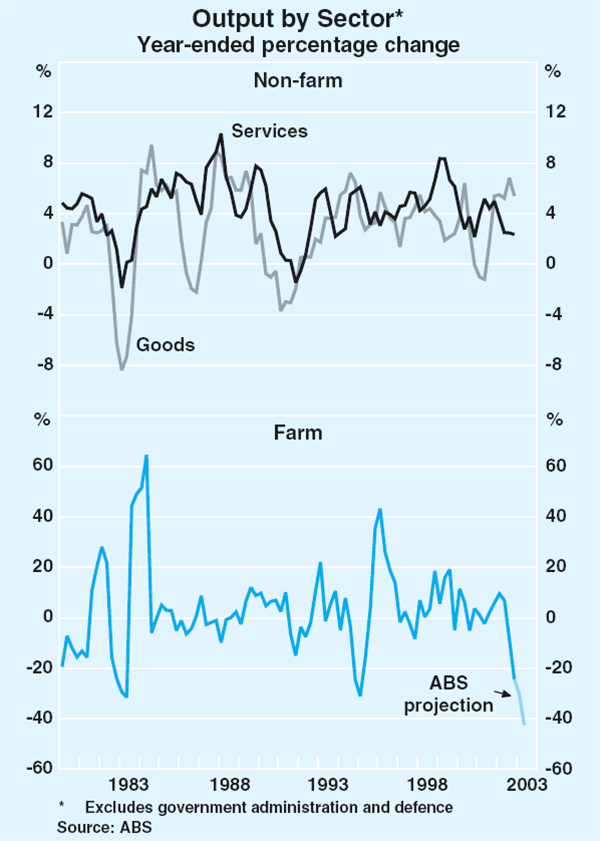
Business surveys continue to indicate that current business conditions and businesses' assessment of their own prospects remain positive (Graph 26). However, they report heightened concerns about future developments in the broader economy. The NAB survey, ACCI Survey of Investor Confidence and ACCI-Westpac survey of the manufacturing industry all recorded a decline in business conditions in the March quarter, but remain consistent with trend growth in the non-farm economy. Indicators of new orders, capacity utilisation and employment reported in the ACCI-Westpac survey remain well above long-run average levels. In contrast, measures of business confidence are weaker, with the NAB survey measure falling below long-run average levels and the ACCI-Westpac survey reporting a sharp fall in confidence among manufacturing businesses, to its lowest level since the beginning of 2001. The Dun & Bradstreet survey continues to provide a more downbeat reading than other surveys, though in contrast to the other surveys it showed an improvement in conditions in the latest quarter. The latest Rabobank rural confidence survey reported a significant improvement in the outlook for the farm sector, particularly in cropping, and in farmers' investment intentions (Graph 27).
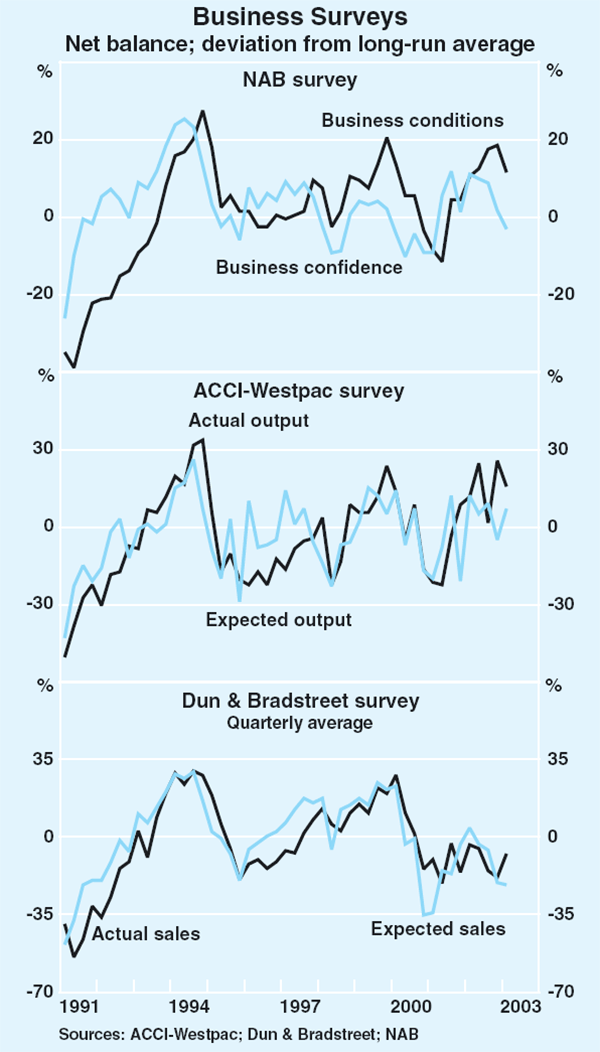
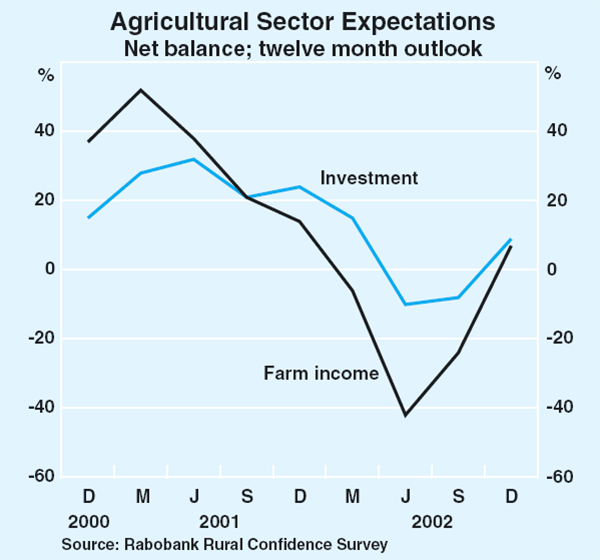
Measured on a national accounts basis, in the half year to December 2002, the gross operating surplus (GOS) of the private corporate sector was up 13 per cent on the corresponding period in 2001. Profit growth was robust in industries such as construction, retail trade and transport & storage, reflecting strength in the domestic economy. In contrast, profits continued to fall in the property and business services sector, and mining profits remained lower over the year despite some recovery in the past couple of quarters. The decline in small business profits in the December quarter, as measured by the income of unincorporated enterprises, mainly reflected a 28 per cent fall in farm incomes caused by the drought. Excluding farm income, small business profits grew by around 10 per cent over the year, reflecting favourable conditions in the residential construction and retail sectors.
Profit growth reported by listed companies was weaker than that reported in the national accounts (Graph 28). In aggregate, net income for the top 100 companies was down 3 per cent compared to the corresponding period in 2001. This fall in income was due to write-downs of assets by several large mining, financial and telecommunications companies.
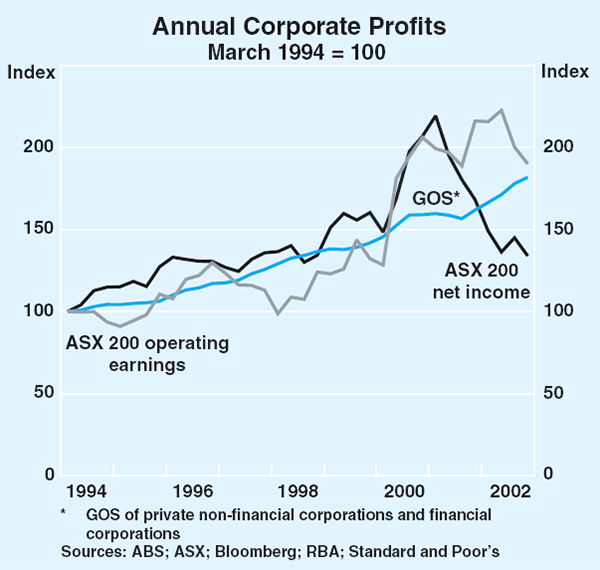
The national accounts measure relates to profits earned in Australia and excludes the effects of asset write-downs. As such, it gives a better indication of the underlying profitability of Australian enterprises. The divergence between this measure and the reported profits of listed companies is due to the large asset write-downs, weakness in offshore earnings and the impact of the appreciation in the Australian dollar on the value of Australian listed companies' offshore operations.
External business funding picked up in the March quarter but still remained lower than the strong levels in the middle part of 2002. The recent pick-up has primarily reflected increased non-intermediated debt raisings; equity raisings have been at a low level for some time. However, the level of corporate internal funding has remained high, owing to the continued increase in profits. Corporate debt interest payments are still around historically low levels as a share of GOS, and consistent with this, business loan arrears remain low.
Business investment rose by 10 per cent in the December quarter and by close to 20 per cent over 2002, underpinned by sound corporate profitability and the availability of low-cost funding (Graph 29). There was rapid growth in spending on machinery and equipment (in part reflecting the purchase of a number of aircraft) and buildings and structures. The nascent recovery in spending on computer software also gathered pace, with growth over 2002 climbing to around 12 per cent.
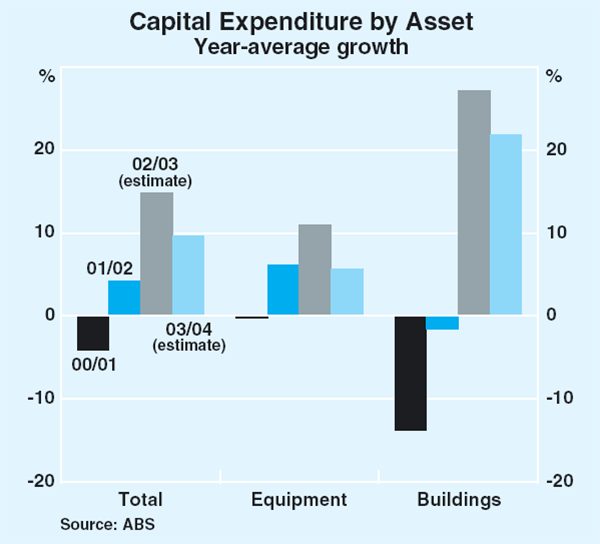
Indicators of investment intentions suggest that the current upswing in business investment has further to run, though some pull-back could occur in the near term, as the large jump in civil aircraft deliveries in the December quarter is partially unwound. The December quarter ABS capital expenditure (Capex) survey suggests that investment in machinery and equipment is expected to grow by around 11 per cent in nominal terms in the current financial year. Continued growth is also likely in the following year; using a five-year average realisation ratio, the Capex survey suggests growth in spending of around 5½ per cent in 2003/04. However, there is uncertainty regarding how firms' investment plans will evolve in light of global economic developments and the war in Iraq, though business surveys suggest that investment intentions have proven resilient to date. The mining, manufacturing and transport & storage sectors are expected to remain strong contributors to growth in equipment investment in the next financial year, together with an anticipated recovery in investment by the service sectors. A modest recovery in agricultural equipment investment may also occur, on the assumption that the drought is breaking.
Most indicators suggest further growth in spending on buildings and structures in both the current financial year and 2003/04 (Graph 30). After rising by almost 60 per cent through 2002, growth in engineering construction is expected to remain robust in the near term, underpinned by a considerable stock of resource and infrastructure work in the pipeline. These projects include the private sector's contribution to numerous state government infrastructure projects, such as preparations for the Commonwealth Games in 2006. However, even with the likely commencement of further large projects, engineering construction activity may well level out during 2004, as many sizeable projects are near completion and some government projects could still be deferred. The value of non-residential building work in the early stages of construction remains large, and with the volume of approvals reaching 13-year highs in the second half of 2002, building activity is set to remain strong in the period ahead. This outlook for expenditure on buildings and structures is supported by the Access Economics Investment Monitor, which has reported continued solid growth in the value of projects recently commenced, with a number of significant projects poised to come on stream in the period ahead.
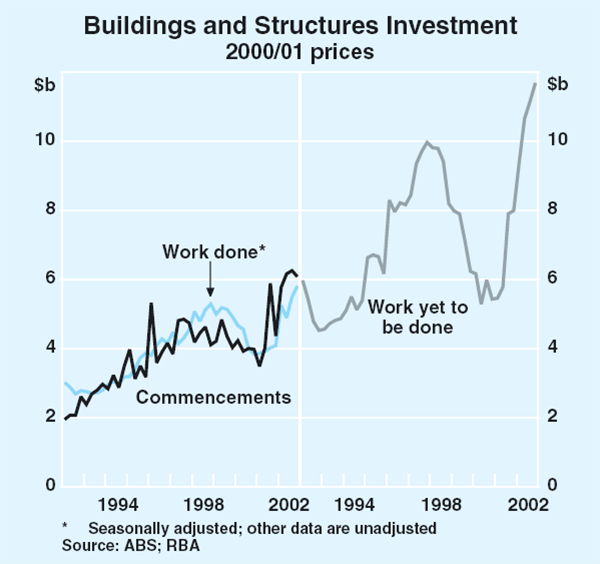
The labour market
Employment increased by a sizeable 3 per cent over the year to the March quarter (Graph 31), with good rises in both full-time and part-time employment. Recent labour force numbers appear to have been affected by the introduction of a new sample, making them more difficult to interpret than usual. However the unemployment rate, which is often less volatile than other indicators, clearly signals that there has been genuine strength in the labour market, having fallen ½ of a percentage point since the March quarter last year. The participation rate reached its highest level on record of 64.4 per cent in the March quarter.
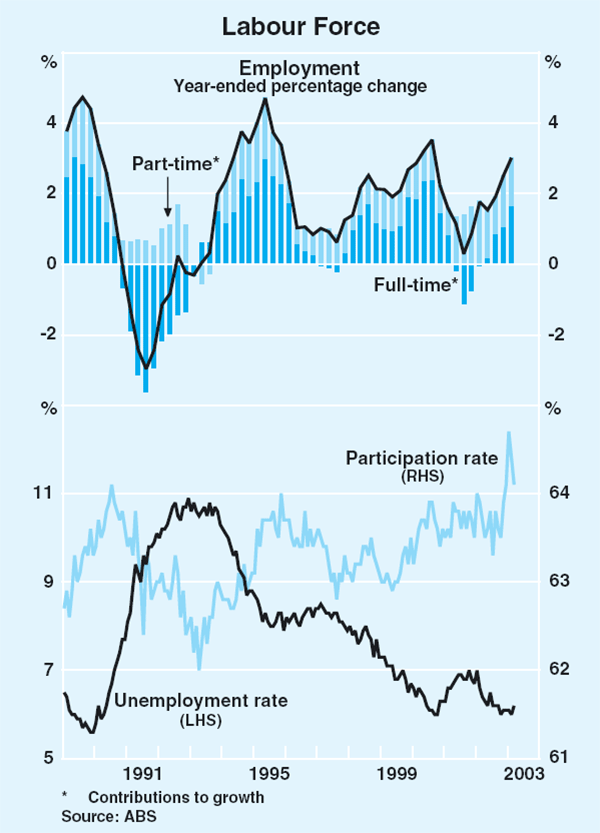
All mainland states enjoyed employment growth of 1 per cent or more in the March quarter, and significantly above-trend growth over the year (Table 8). Employment has remained strongest in Queensland, rising by nearly 4 per cent over the year to the March quarter. Most mainland states also experienced a significant decline in their unemployment rates over the year. Tasmania continues to lag the other states in terms of both employment and unemployment outcomes.
| Employment growth | Unemployment rate | ||||
|---|---|---|---|---|---|
| March quarter |
Year to March quarter |
March quarter |
Year to March quarter(a) |
||
| NSW | 1.5 | 2.7 | 5.9 | −0.2 | |
| Victoria | 1.3 | 3.0 | 5.4 | −0.8 | |
| Queensland | 1.6 | 3.9 | 7.1 | −0.7 | |
| WA | 1.0 | 3.0 | 5.7 | −0.7 | |
| SA | 1.8 | 3.4 | 6.1 | −0.8 | |
| Tasmania | 0.6 | 1.4 | 9.1 | 0.4 | |
| Australia | 1.3 | 3.0 | 6.1 | −0.5 | |
|
(a) Percentage point change Source: ABS |
|||||
Outcomes for employment by industry were generally in line with the pattern of output growth over the year (Table 9). Employment growth was particularly strong in construction and retail & wholesale trade, consistent with strength in dwelling investment and consumer spending. However, employment in the accommodation, cafes & restaurants sector contracted over the year, reflecting subdued conditions in the tourism sector. The drought has resulted in a marked decline in agricultural employment, with declines in farm employment most acute in northern and western NSW where the drought has been especially severe.
| Growth | ||
|---|---|---|
| Industry | Share of total 2002 |
Year to March quarter 2003 |
| Public sector(a) | 22.2 | 4.6 |
| Retail and wholesale trade | 19.9 | 4.8 |
| Manufacturing | 12.0 | 4.3 |
| Property and business services | 11.5 | 2.0 |
| Construction | 7.6 | 8.1 |
| Accommodation, cafes and restaurants | 4.9 | −4.3 |
| Agriculture | 4.3 | −18.8 |
| Transport and storage | 4.3 | 2.2 |
| Personal and other services | 4.0 | 11.5 |
| Finance and insurance services | 3.7 | 6.3 |
| Cultural and recreational services | 2.6 | −3.6 |
| Communication services | 1.8 | 2.0 |
| Total(b) | 100.0 | 3.0 |
|
(a) Includes utilities, public administration & defence, education
and health & community services Source: ABS |
||
Forward-looking indicators of labour demand have reported mixed signals in recent months, but overall point to continued employment growth in the near term, though at slower rates than have been experienced recently (Graph 32). The ABS employer-based job vacancies series reported a very strong rise of 15 per cent in the three months to February, to be 22 per cent higher over the year. In contrast, both the ANZ and DEWR print vacancies series were broadly flat in the quarter and over the year, after accounting for the possible effects of public holidays. The latest readings of the NAB, ACCI-Westpac and Dun & Bradstreet surveys all indicated a slight increase in employment intentions for the coming quarter.
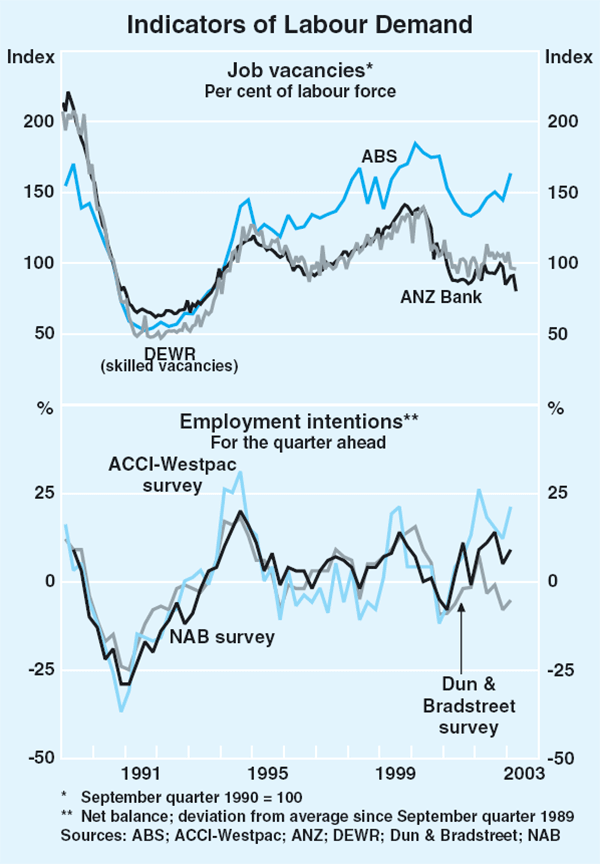
Box C: Measuring Household Debt Servicing Costs
As has been discussed in recent articles published in the RBA Bulletin, the sustainability of debt levels depends importantly on the share of borrowers' incomes required to service the debt, that is, the payment of the associated interest costs.[1]
In assessing the level of debt service, the RBA makes two adjustments to the measure of household interest payments published by the ABS in the national accounts. Firstly, the ABS deducts a portion of the interest paid as being payment by households for the financial intermediation services provided by financial institutions. The spread between the interest rates at which financial intermediaries borrow from the public and the interest rates at which they lend is assumed to represent the price of intermediation services to households. The service charges imputed from the interest spread, referred to as Financial Intermediation Services Indirectly Measured (FISIM), are attributed to both borrowers and depositors to capture this means of recovering the costs of financial intermediation. A series of actual (gross) interest payments on debt, which adds back the imputed service charge, can be constructed based on unpublished ABS data.
Secondly, even taking account of the above adjustment, recent levels of interest payments appear too low given the levels of debt and prevailing interest rates. To account for this, from the December quarter 2000, the gross interest payments data have been adjusted so that the implied average interest rate maintains a margin over the cash rate consistent with that observed in recent years.
The resultant series is shown as the upper line on Graph C1; it has fluctuated with the interest rate cycle around a gradual upward trend. The lower line in Graph C1 shows the equivalent series for the debt-servicing requirement for mortgage debt alone. This series shows a clearer upward trend, with more moderate cyclical swings.
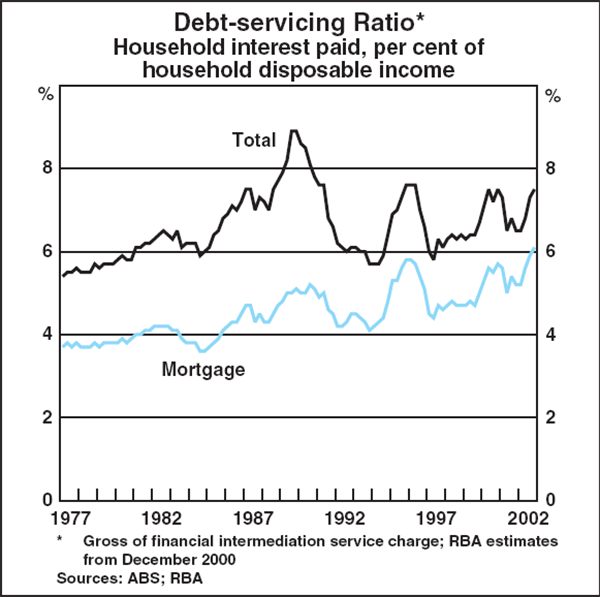
Currently mortgage interest payments account for around 6 per cent of household disposable income, around 1 percentage point higher than in 1990. The increase in the mortgage debt-servicing ratio has occurred because the ratio of outstanding mortgage debt to income has risen substantially since 1990, which has more than offset the effect of lower mortgage interest rates.
Allowing for required principal repayments as well as interest payments would increase the current level of the debt-servicing ratio by an additional 2½ percentage points or so, an amount which is likely to have increased in recent years along with rising debt levels. It is also worth noting that because the majority of households have no mortgage debt, the servicing cost for those households that do is a good deal higher than indicated by the aggregate figure.
While following the same general trend as mortgage interest costs for much of the past two decades, total interest costs peaked in the late 1980s. Personal loans, which carry a relatively high interest rate, were a much larger share of total household debt at that time than they are now, and the average interest rate on personal loans rose more in the late 1980s than did mortgage rates.
Balance of Payments
The continuation of robust growth in demand in Australia but subdued demand abroad has led to a widening in the trade deficit over the past year and a half, although it narrowed in the March quarter. Assuming that the net income deficit as a proportion of GDP remained constant in the quarter, the current account deficit is likely to have narrowed to around 5¾ per cent of GDP, from 6.2 per cent of GDP in the December quarter (Graph 33).
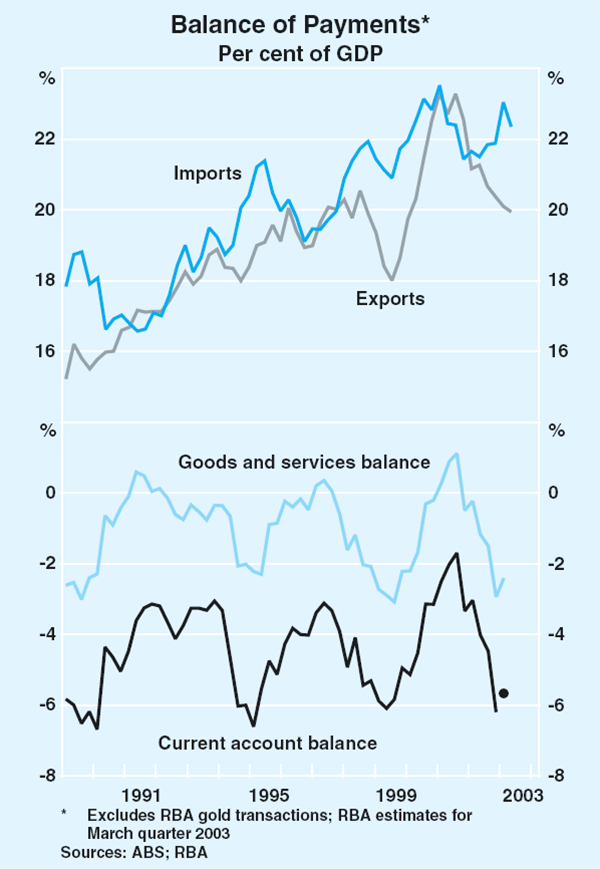
The subdued growth in demand in much of the rest of the world has resulted in falls in the value of resources and manufactured exports over the past year (Table 10). Resources exports did however record a rise of around 1½ per cent in the March quarter, primarily reflecting an increase in exports of metal ores and minerals. Coal and gold exports, in both value and volume terms, also rose over the past six months.
| Values | Volumes | |||
|---|---|---|---|---|
| Year to March quarter 2003 |
Average annual growth over 1990s |
Year to March quarter 2003 |
Average annual growth over 1990s |
|
| Rural | −18.5 | 4.1 | −13.5 | 5.7 |
| Resources | −1.2 | 5.2 | 1.0 | 6.6 |
| Manufactures | −1.9 | 12.3 | 4.3 | 12.6 |
| Services | 2.5 | 9.1 | 0.0 | 7.4 |
| Total | −0.8 | 6.9 | 1.7 | 7.4 |
|
(a) Excludes RBA gold transactions; RBA estimates for March quarter 2003 Sources: ABS, RBA |
||||
The effects of the weak world economy on services exports have been compounded by heightened concerns about international travel; the modest growth that has occurred in service export earnings over the past year is largely accounted for by price rises. The number of short-term overseas visitor arrivals remains below August 2001 levels (Graph 34) and is likely to continue to be weak in the period ahead, with ongoing fears about terrorism and the spread of SARS.
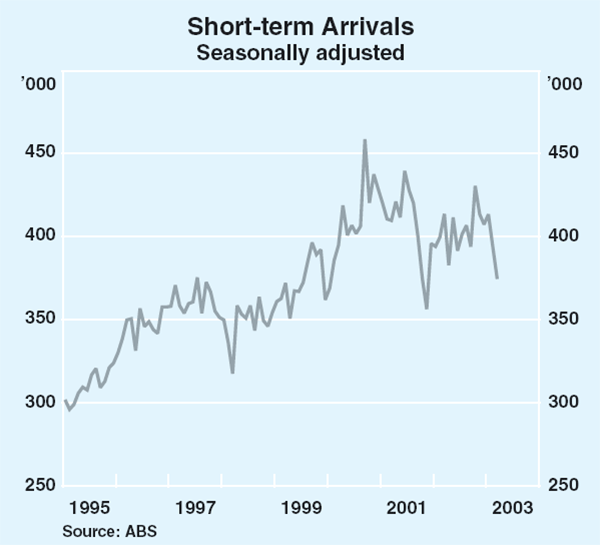
The value of rural exports fell by nearly 20 per cent over the year to the March quarter, reflecting the continued impact of the drought. Drought-related shortages of cereals and wool resulted in higher prices for these exports, partially offsetting the effect of the drought on export volumes. Conversely, meat prices have fallen while volumes have risen strongly as a result of the drought.
The Bureau of Meteorology declared in early May that the El Niño event is over. While some areas of the country have not yet had significant follow-up rain to the falls in February, the Bureau believes most drought-affected areas should see appreciably more winter and spring rains in 2003 than in 2002. ABARE is predicting a strong recovery in farm production in 2003/04, though not quite to levels prevailing prior to the drought. The wheat crop in 2003/04 is expected to be more than twice that of the previous year, but slightly less than the crop in 2001/02. Production of crops such as rice and cotton, however, is unlikely to bounce back in the short term, owing to continuing shortages of irrigation water. The recovery of meat and wool production is also likely to be gradual, given the need to rebuild depleted herds and flocks.
The strength of domestic demand, and particularly business investment, in Australia resulted in import growth of around 10 per cent over the year to the March quarter. Imports of capital goods rose by around 9 per cent over the year, notwithstanding a decline in the March quarter as the value of aircraft imports returned towards a more normal level (Graph 35). Imports of consumption goods have been boosted over the past year by a strong rise in motor vehicle imports, in line with the growth in domestic motor vehicles sales, while the sharp rise in imports of intermediate goods in part reflected the sharp rise in the price of oil over the past year.
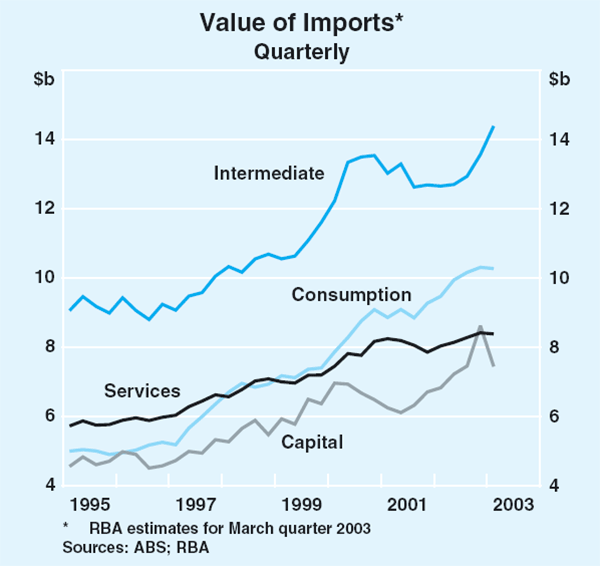
The net income deficit widened slightly in the December quarter, to around 3.2 per cent of GDP. The ratio of net income payments to exports, a measure of Australia's ability to service its liabilities, has risen over the past couple of years but, at 16 per cent, remains low by historical standards. Australia's net foreign liabilities rose by 1½ per cent in the December quarter, to around 56½ per cent of GDP. An increase in net foreign debt, primarily reflecting a continuation of the recent trend of strong net debt inflows, offset a small decline in net foreign equity liabilities.
Commodity prices
Commodity prices have fallen since the beginning of the year (Graph 36). Rural commodity prices have declined by more than 9 per cent since their peak in October 2002, and have broadly unwound the drought-related price increases that occurred in 2002. Wheat prices have fallen by around 25 per cent over this period in expectation of the breaking of the droughts in the US and Australia. Beef and veal prices have fallen further because of the combination of weak external demand and increased domestic slaughter rates, but are expected to rise sharply in the near term as a result of rainfall returning to more normal levels.
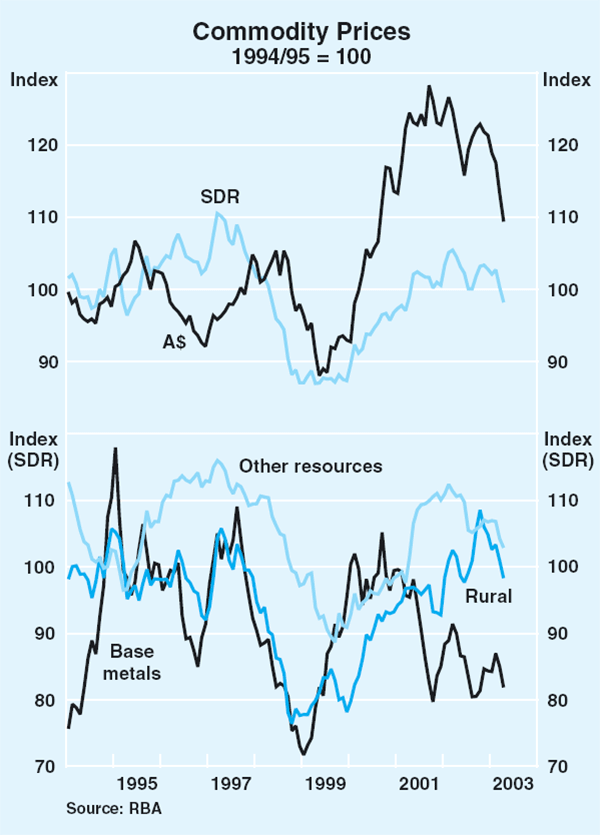
The war in Iraq has resulted in significant volatility in the prices of oil and gold in recent months. The price of gold rose to over US$380 per ounce in early February, but has subsequently declined by more than 10 per cent. Oil price developments are discussed in detail in the chapter on ‘International Economic Developments’. After rising sharply in February, base metals prices have fallen to below their level at the beginning of the year. The rise in February and the subsequent fall have primarily resulted from movements in the prices of aluminium and nickel.
A major contract for the export of Australian hard coking coal to Japan this year was settled in late March, with prices 4.3 per cent lower than in 2002 in US dollar terms (Graph 37). Australian thermal coal producers also concluded a major contract negotiation for the Japanese market, agreeing on a 6.8 per cent price fall from last year.
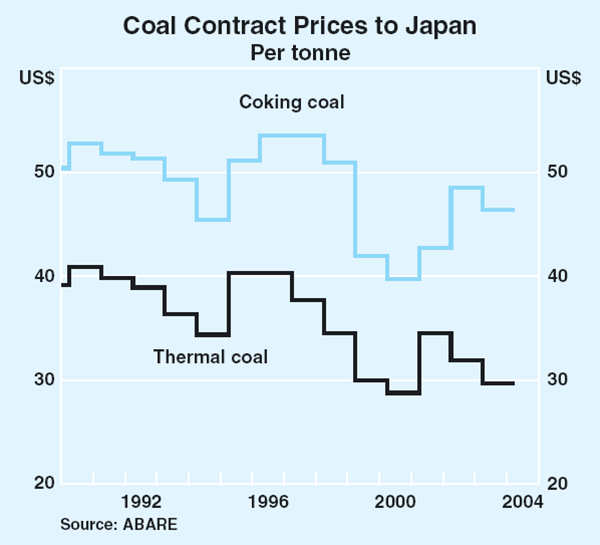
Domestic Financial Markets
Interest rates and equity prices
As in offshore markets, the predominant influence on domestic financial markets for much of the past three months has been the Iraq situation, rather than the usual flow of economic news. Bond yields and share market prices fell through February and the early part of March, reflecting rising uncertainty as military preparations gathered pace (Graph 38). In mid March, once it became clear that war was imminent, domestic markets experienced the same sharp reversals seen in other countries, with share prices and bond yields rising. The reversal reflected the prevailing view that the war would be over quickly and that therefore the downside economic risks to the world economy were limited. Domestic bond yields and equity prices ended the period slightly above the levels prevailing at the time of the previous Statement.
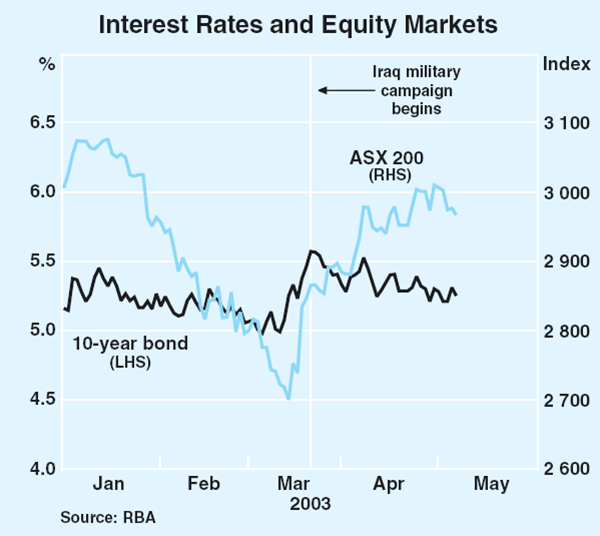
Money and bond market interest rates
Short-term interest rates, particularly in the six to twelve month maturities, declined ahead of the commencement of hostilities in Iraq, as uncertainty about the nature of the conflict and its possible economic impact mounted. The 180-day bank bill yield, which was around 4.75 per cent at the end of January, reached a low of 4.60 per cent near the middle of March. However, the subsequent sharp rise in rates means that there has been little net change in short-term market yields over the past three months.
The target cash rate has remained unchanged at 4.75 per cent over the past three months. Money market expectations of a monetary policy easing that existed three months ago have persisted, but they have been pushed back somewhat. The money market is currently factoring in a reduction of 25 basis points in the target cash rate during the third quarter of this year (Graph 39). In early March, when concern about the economic impact of a conflict in Iraq was at its peak, the market began to price in a second reduction in the target cash rate by the end of the year. However, this proved short-lived.
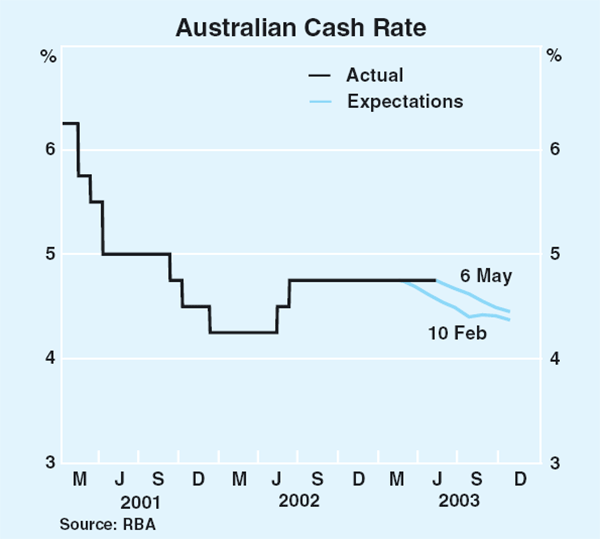
As noted, movements in domestic bond yields over the past three months have also been heavily influenced by developments in the Iraq situation. Despite a continued run of generally positive domestic economic news, 10-year government bond yields declined through February and early March, reaching a two-year low of 4.98 per cent. They then rose sharply to almost 5.60 per cent in the middle of the month as government bond yields in the US moved higher on the prospect of a short military campaign. This rise has since been partly reversed as investors have refocused their attention on the global economic outlook. Yields on 10-year government bonds were around 5.25 per cent in early May, close to their average level in January (Graph 40).
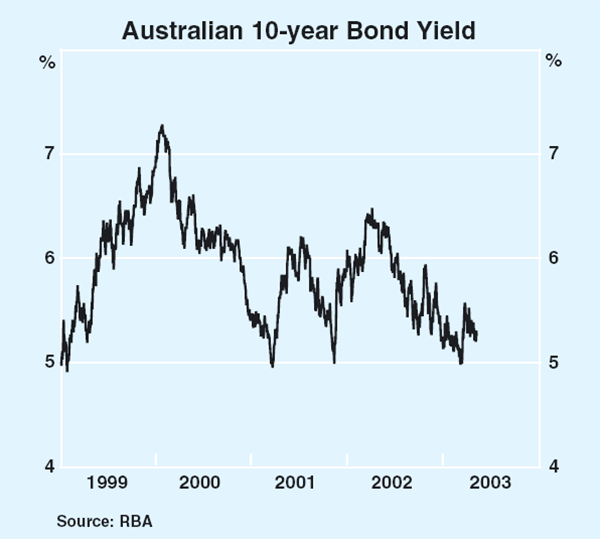
The yield curve in Australia remains relatively flat. The spread between 10-year government bond yields and cash is now around 50 basis points, around half its long-run average. Yields out to maturities of three years remain at levels below the cash rate (Graph 41). This pattern in the yield curve suggests that markets attach a greater probability to falling, rather than rising, interest rates in the period ahead.
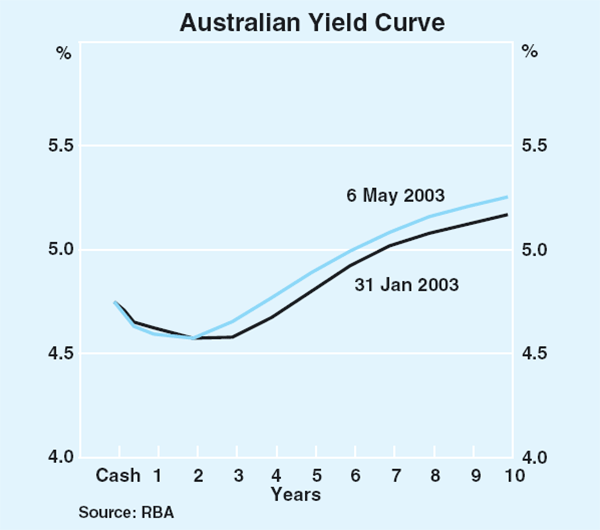
The move lower in government bond yields in February and early March was less pronounced in Australia than in the US, reflecting among other things the stronger economic news domestically. As a result, the 10-year nominal yield differential between these two markets widened significantly around that time, touching a six-month high of almost 170 basis points. Since then, the spread has narrowed to 140 basis points as US yields have risen. The current spread remains well above the average spread of about 50 points that prevailed between 1997 and 2001 (Graph 42).
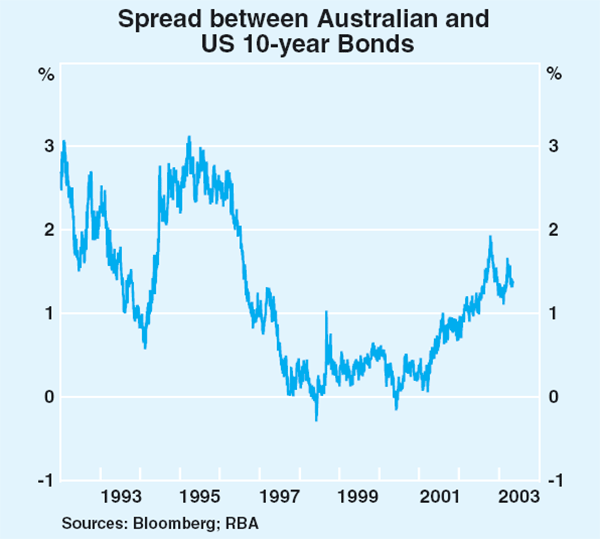
Like nominal yields, real bond yields in Australia declined through February and early March, the yield on 10-year government indexed bonds falling by around 30 basis points from end January to 2.85 per cent. This was a much smaller fall than that in US real yields and, as a result, the 10-year real bond yield spread between the two markets widened from 120 basis points in January to 165 basis points in mid March (Graph 43). As in the case of the nominal yield spread, some of this was subsequently reversed as US real yields rose. In early May, the real 10-year bond yield spread stood at just over 115 basis points.
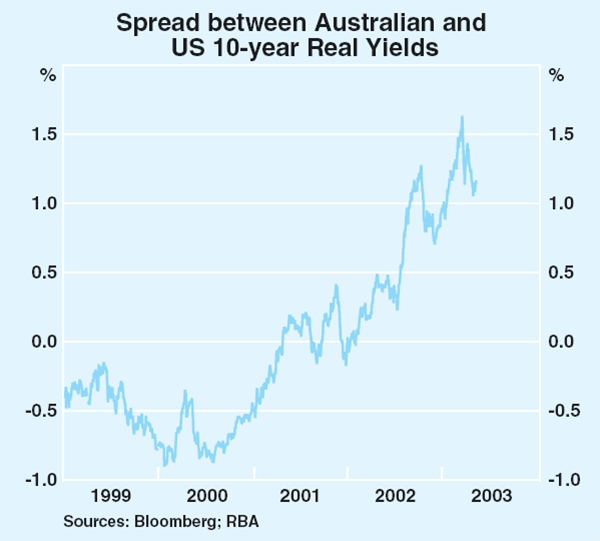
Credit spreads
Credit spreads on Australian corporate bonds have continued to narrow over the past three months (Graph 44). Factors contributing to this have included the diminished supply of new debt (see below), some switching from equities into bonds by investors, and some general decline in risk aversion since late last year. The narrowing of credit spreads in the Australian market mirrors trends seen in the US. Spreads on some non-residents' issues (particularly non-resident financial institutions) have narrowed significantly. Credit spreads are now around 25 basis points below the peaks seen in October last year and slightly below their historical averages.
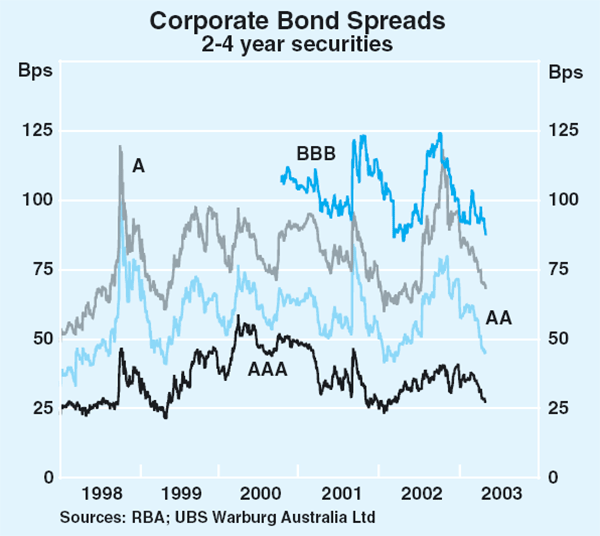
Equity prices
After tracking sideways for much of the December quarter, domestic equity prices began declining in January on the back of some company-specific news and more general concerns about weakness in the global economy. Fears about the possible economic fall-out from a war in Iraq weighed increasingly on the equity market through February and early March. By mid March, the ASX 200 index was down 10 per cent from the start of the year (Graph 45). As prospects for a quick resolution of the Iraq conflict strengthened, the market rebounded strongly and in early May equity prices were around the same level as at the start of the year. By comparison, the US S&P 500 is 5 per cent higher than its level at the start of the year. Over the longer term, however, the Australian market has held up well compared to its US counterpart, with the ASX 200 falling 4 per cent over the past three years compared to a fall of 37 per cent in the S&P 500.
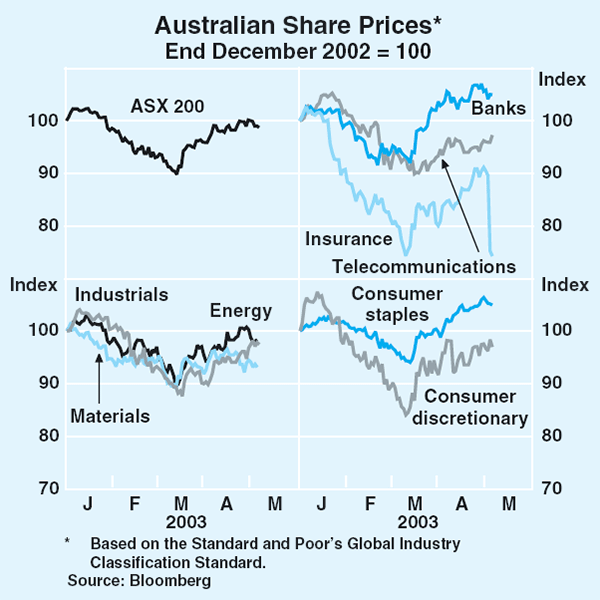
The recent rebound in equity prices has been broadly based, with all sectors rising since mid March. The energy, consumer staples, financial and utilities sector indices are currently back above their early January levels, while other sector indices remain below their end-January levels. Within the financial sector, the index of bank share prices has risen while the comparable index for insurance companies has fallen. The insurance sector index of the ASX 200 is currently around half its peak level in June 2001.
Uncertainty relating to the Iraq situation saw measures of future equity market volatility derived from options rise noticeably through early 2003 (Graph 46). The rise in volatility was associated with the market factoring in a greater likelihood of large falls in equity prices. These concerns also led to high levels of trading activity in the futures market throughout March. In line with the rebound in sentiment in the equity market itself since mid March, much of the rise in volatility and perceived downside risk has since been reversed. Expected volatility remains above the levels seen at the start of the year, though only around half the volatility in the US market, and well below the volatility that was evident in the late 1990s.
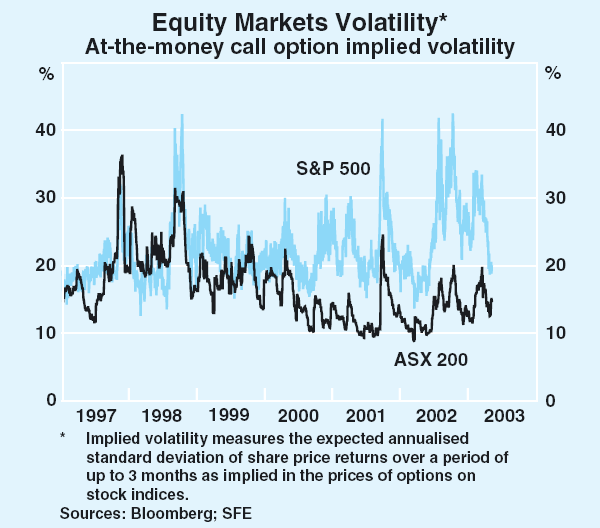
The recent rise in equity prices coupled with a fall in reported earnings (refer the chapter on ‘Domestic Economic Activity’) has seen a slight increase in Australia's P/E ratio, to 28 (Graph 47). Losses reported by News Corporation during the past 12 months continue to affect the aggregate P/E ratio; excluding News Corporation, the ratio is around 18, which is around its long-run average.
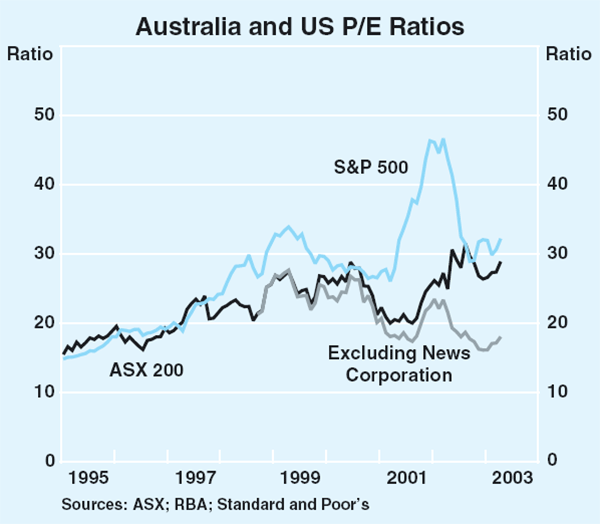
Reflecting the outcomes for the six months to December and some scaling back by companies of expected future earnings, analysts have revised down their forecasts for earnings per share for 2002/03. Year-on-year growth of just 1 per cent is now expected for the ASX 200 companies (down from 10 per cent in January). Downward revisions were most pronounced for the financial, telecommunications and health care sectors. Earnings per share forecasts for 2003/04 have also been revised lower, although not to the same extent as forecasts for the current financial year (Graph 48). As a result, earnings per share are forecast to increase by 22 per cent in 2003/04.
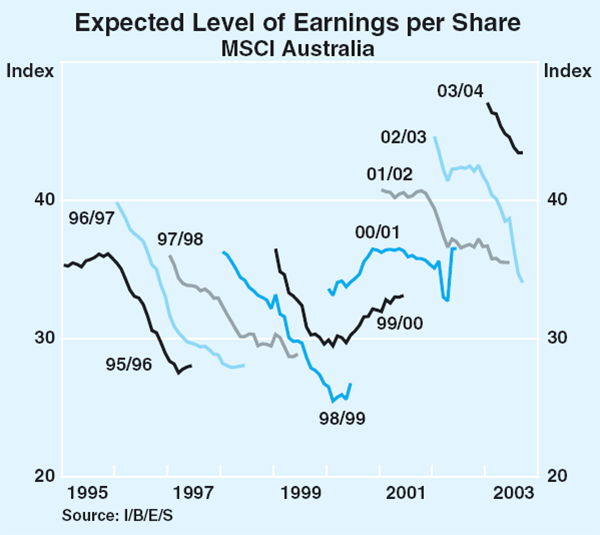
In recent years, companies have generally maintained or increased their dividend payouts and the aggregate dividend payout ratio and dividend yield have risen. The aggregate dividend yield is now broadly similar to the returns paid on money market securities, a situation which is quite unusual compared with the experience of the past 20 years (Graph 49).
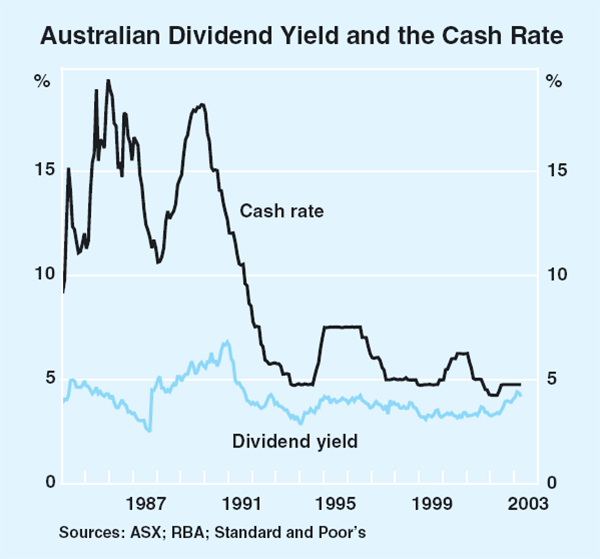
Intermediaries' interest rates
Intermediaries' interest rates on variable-rate loans have been unchanged since June 2002 reflecting the constant target for the cash rate (Table 11). In contrast, banks' indicator fixed rates for housing loans have declined considerably over this period. Since the previous Statement, banks' 3-year fixed housing rates have fallen by 25 basis points. This decline largely reflects a delayed response to falls in the swap rate in late 2002. While fixed housing rates are now almost half a percentage point lower than standard variable rates, the proportion of approvals for fixed-rate loans has declined in recent months. This perhaps suggests that home owners remain of the view that interest rates could fall further in the future. Fixed interest rates on loans to small businesses have changed little so far in 2003, though they remain 105 basis points below the level prevailing at the end of June 2002.
| Current level (6 May) |
Change since end January 2003 |
|
|---|---|---|
| Variable rates | ||
| Household | ||
| Mortgages: | ||
| – Standard variable | 6.55 | .. |
| – Basic housing | 6.00 | .. |
| – Mortgage managers | 6.35 | .. |
| Personal lending: | ||
| – Residential secured | 6.70 | .. |
| – Credit cards | 16.00 | .. |
| Small business | ||
| Residential secured: | ||
| – Overdraft | 7.30 | .. |
| – Term loan | 6.75 | .. |
| Other security: | ||
| – Overdraft | 8.00 | .. |
| – Term loan | 7.35 | .. |
| Large business | ||
| – Overdraft | 8.35 | .. |
| – Term loan | 8.20 | .. |
| Cash rate | 4.75 | .. |
| Fixed rates (3 years) | ||
| Housing | 6.10 | −0.25 |
| Small business | 6.35 | 0.05 |
| Swap rate | 4.90 | 0.05 |
|
Source: RBA |
||
Financing activity
Overall financing activity remains robust due to the continued strong growth in intermediated credit, particularly household credit. Overall bond issuance also remains strong, though there has been a switch from domestic to offshore issuance reflecting favourable borrowing conditions in offshore markets. Financing activity in the equity market, however, remains at a low level.
Intermediated borrowing
Total credit increased at an annual rate of 11.8 per cent over the six months to March, continuing the strong pace of growth evident over the past year (Graph 50). The strength in growth in total credit has continued to be underpinned by strong growth in household credit, particularly for housing-related purchases. Growth in business credit has been fairly subdued in recent months.
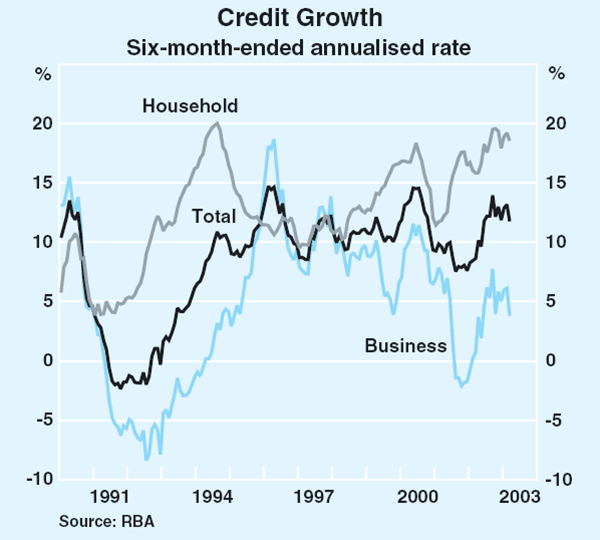
Housing credit increased at an annualised rate of 21.2 per cent over the six months to March, slightly faster than the pace in the previous six months. This is in line with earlier strength in housing loan approvals, which rose strongly over 2002 driven mainly by a rise in approvals to investors. Consistent with this, growth in credit for investor housing has continued to outpace growth in housing credit for owner-occupation. While remaining at very high levels, loan approvals for both owner-occupiers and investors have levelled off recently. Personal credit continues to grow at a more moderate pace than in the middle of 2002, though growth has picked up in recent months.
After showing some strength around the end of 2002 and into 2003, growth in business credit has been more subdued over recent months. Over the three months to March, business credit increased by 5.5 per cent in annualised terms, compared with annualised growth of 8.6 per cent over the three months to January. A trend fall in commercial loan approvals over the past six months suggests that growth in business credit is likely to remain moderate.
On the other side of financial intermediaries' balance sheets, growth in the broader monetary aggregates has remained firm over the past few months (Graph 51). Over the six months to March, broad money grew by 12.4 per cent in annualised terms, compared with annualised growth of 9.1 per cent over the six months to September. Growth in broad money over the past three months has been broadly in line with growth in credit.
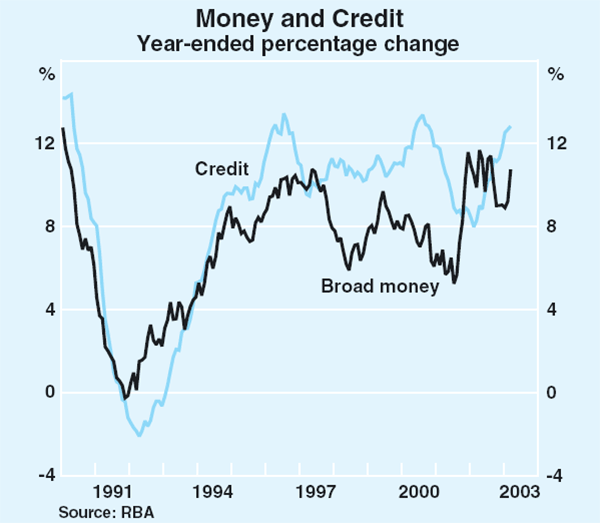
Debt markets
Total bond issuance for the March quarter was $30.6 billion, somewhat larger than both the outcome in the previous quarter ($24.5 billion) and the quarterly average for 2002 ($24 billion). Financial institutions and asset-backed vehicles were the main issuers.
The noticeable characteristic of the quarter was the switch from domestic to offshore issuance. Non-government debt issuance in the domestic market slowed to $6.2 billion, about one-third less than average quarterly issuance over the past four years (Table 12). Offshore issuance, in contrast, was a record $24.5 billion, up almost 60 per cent compared to the December quarter. April has seen a continuation of the March quarter trend of subdued domestic issuance and strong offshore issuance.
| 2000 | 2001 | 2002 | 2002 | 2003 | |||
|---|---|---|---|---|---|---|---|
| Sector | December quarter |
March quarter |
April | ||||
| Financial intermediaries | 23.3 | 29.7 | 39.8 | 10.5 | 15.6 | 4.6 | |
| Non-financial companies | 11.6 | 12.5 | 14.7 | 4.5 | 5.4 | 0.2 | |
| Non-residents | 3.5 | 7.8 | 3.1 | 0.0 | 0.2 | 0.0 | |
| Asset-backed | 20.5 | 29.3 | 38.4 | 9.4 | 9.4 | 0.7 | |
| Total | 58.9 | 79.3 | 95.9 | 24.5 | 30.6 | 5.5 | |
| of which: | |||||||
| – Offshore | 30.8 | 44.4 | 58.2 | 15.4 | 24.5 | 4.2 | |
| – Onshore | 28.1 | 34.9 | 37.8 | 9.1 | 6.2 | 1.3 | |
|
Source: RBA |
|||||||
The strength of offshore issuance reflects strong overseas demand for Australian dollar securities. This is encouraging many non-residents to issue Australian dollar debt that they then swap back into their own currency. In doing so, they have moved swap spreads in a way that has made it very attractive for Australian borrowers to issue foreign currency debt and swap it into Australian dollars (see Box D). The bulk of offshore issuance by Australian borrowers was denominated in foreign currencies (and subsequently hedged) (Graph 52). As is usually the case, offshore issuance has been dominated by financial institutions.
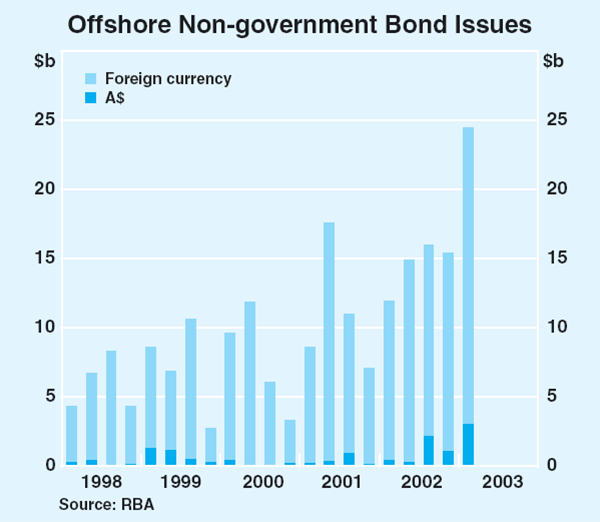
Domestic non-government bond issuance over the quarter was just sufficient to match maturities, leaving the volume of non-government debt little changed at $125 billion (Graph 53). Total debt outstanding has held steady around this level since October last year.
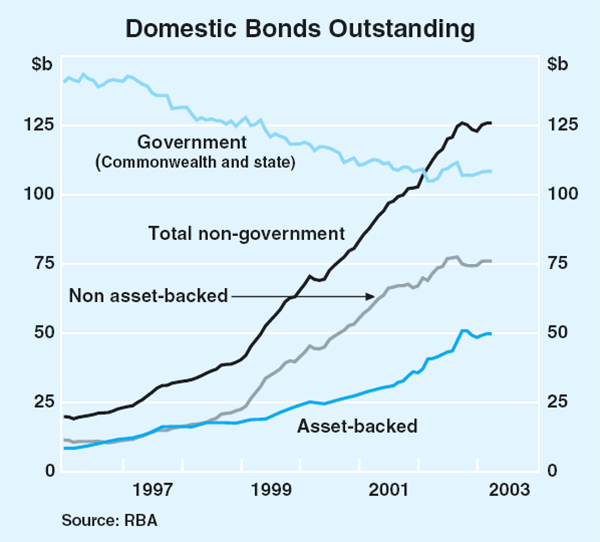
Equity raisings
The slowdown in equity market issuance since the peak in the June quarter of 2002 continued in the most recent quarter (Graph 54). During the March quarter just $1.1 billion was raised by non-financial companies. Raisings were again dominated by secondary issues, particularly private placements, dividend reinvestment plans and rights issues. In addition to the AMP capital raising currently underway, the Promina insurance group is due to list on 12 May and is expected to raise up to $2 billion. A public listing by Virgin Blue airlines has also been proposed.
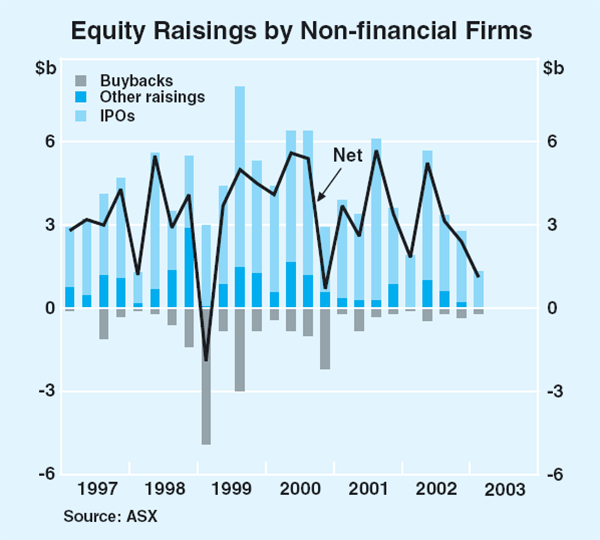
Box D: Offshore Issuance of Australian Dollar Denominated Bonds
The first quarter of 2003 saw unprecedented offshore issuance of Australian dollar denominated bonds. In total, $15.5 billion of Australian dollar Eurobonds were issued, about three times the quarterly average of the previous year. Three-quarters of the bond issues were by non-Australian borrowers (Graph D1), and approximately two-thirds of the bonds were sold to Japanese retail investors in the so-called uridashi market (Graph D2).
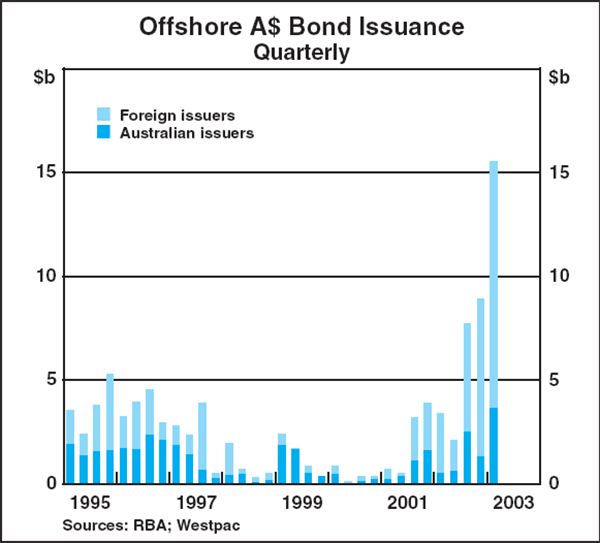
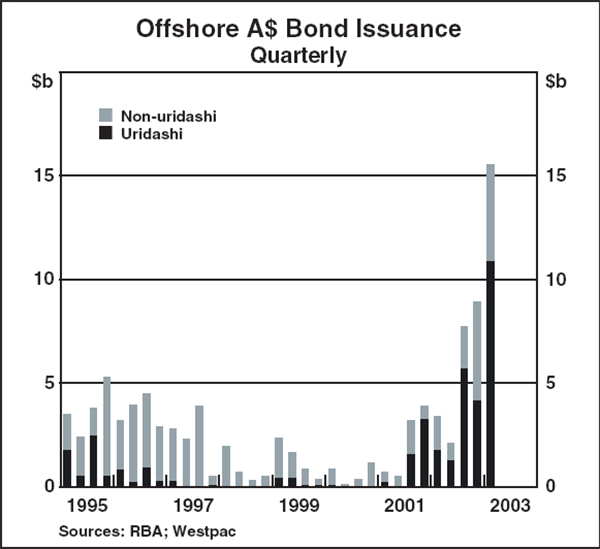
The strong offshore demand for Australian dollar bonds reflects the relatively high yield on Australian bonds and the perceived undervaluation, and expected appreciation, of the Australian dollar. The historically low interest rates in Japan have made Australian dollar bonds particularly attractive to Japanese retail investors.
The strong demand by offshore investors has allowed borrowers issuing bonds offshore to obtain cheaper funding than would have been available had they issued bonds in the domestic market. Indeed, a number of highly rated borrowers have issued uridashi bonds at lower yields than those prevailing on Australian government bonds. Even after the additional costs incurred in marketing an issue through the retail network of a Japanese broker are taken into account, uridashi funding has been cheaper than other forms of Australian dollar denominated finance. Consistent with this, there has been some substitution away from the domestic bond market, particularly by highly-rated non-resident borrowers.
Many issuers of fixed-rate bonds (which includes most Australian dollar Eurobonds) look to swap the fixed interest rate into a floating interest rate. In addition, non-resident issuers may also look to swap the proceeds into their domestic currency.[1] With Australian dollar bond issuance by non-residents rising sharply in recent months, there has been a commensurate increase in swap market activity which has had an impact on rates in the swap markets.
The increased volume of offshore Australian dollar bond issuance has increased the demand to receive fixed interest in the domestic interest rate swap market, causing the swap rate to decline. The downward pressure has flowed through to government bond yields as the swap counterparties, in turn, have hedged their interest rate risk by buying government bonds. This effect has been less marked than the effect on the swap rate, so the differential between the swap rate and the government bond yield (the ‘swap spread’) has fallen (Graph D3).
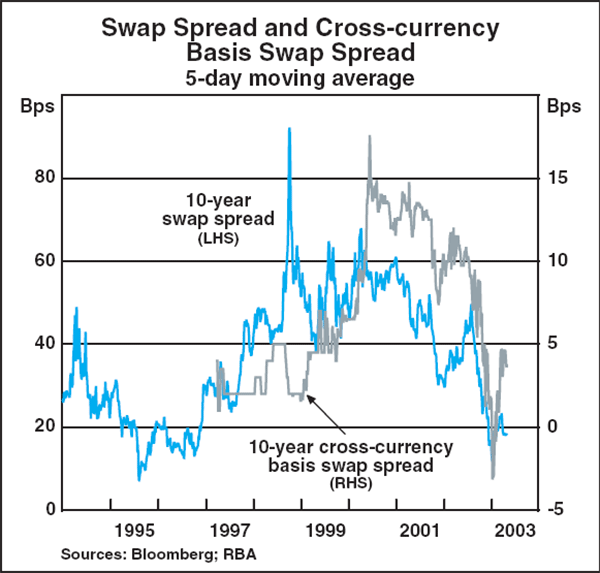
Similarly, strong issuance by non-Australian borrowers has affected pricing in the cross-currency swap market. Historically, there has been more demand for swaps where the counterparty pays an Australian dollar interest rate and receives a US dollar interest rate than the other way round. The balance of demand stems in part from the smaller size of the Australian dollar market relative to that of the US dollar. As a result, the counterparty paying the Australian dollars generally has had to pay a small premium (known as the ‘basis swap spread’) over the Australian floating rate. Increased demand from uridashi and other Eurobond issuers to pay US dollars and receive Australian dollars in the first quarter of 2003 caused the basis swap spread to decline to the point where it became negative, although it has subsequently recovered somewhat.
Other things equal, the decline in the basis swap spread has made it more attractive for Australian borrowers to issue in foreign currency and swap the proceeds into Australian dollars than to borrow in Australian dollars. Consistent with this, the first quarter of 2003 also saw record foreign currency issuance by Australian companies. At least some of the issuance appeared to be substitution away from Australian dollar bonds (Graph D4).
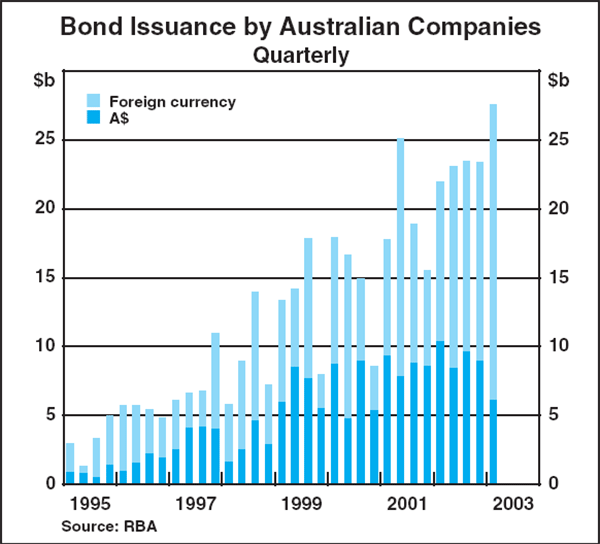
Assessment of Financial Conditions
With the cash rate unchanged since June last year, the general structure of short-term interest rates remains much as was described in the February Statement. Prior to the two increases in mid 2002, the cash rate had been at a historical low of 4.25 per cent, and its current level of 4.75 per cent remains towards the lower end of the range in which it has fluctuated during the past decade. Variable interest rates of financial intermediaries have generally moved in line with the cash rate in recent years, and are similarly close to their historical lows. Measures of real interest rates confirm the picture that levels of short-term rates are relatively low in historical terms. Based on a variety of alternative measures of inflation expectations, the cash rate and indicator rates of financial intermediaries in real terms are currently as much as 1 percentage point below their averages of recent years (Graph 55); they are somewhat further below average if the comparison is made over a longer time period. Hence the increases which took place in mid 2002 have brought short-term interest rates up from their recent lows, but based on a range of historical benchmarks they remain at levels that are relatively expansionary.
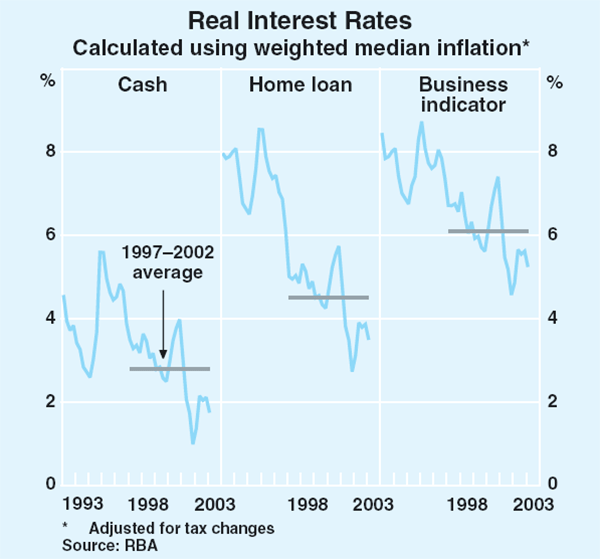
Long-term bond yields have declined markedly over the past year, with the bulk of the decline occurring in the second half of 2002. This movement occurred at a time when bond yields were declining around the world, reflecting downward reassessments of growth prospects in the major economies and, consequently, downward revisions to the expected medium-term path of short-term interest rates. The decline in bond yields contributed to a flattening of the yield curve in Australia over the past year, though this has broadly stabilised in the past few months. With bond yields generally fluctuating in a range between around 5 and 5½ per cent recently, the yield curve has been relatively stable in the past few months, and has remained moderately upward sloping.
Reflecting borrowing rates that are close to historical lows, businesses and households do not appear to be constrained to any significant degree by the cost and availability of credit. As discussed above in the chapter on ‘Domestic Financial Markets’, credit to the household sector is growing at an exceptionally fast pace at present. Borrowing by businesses has been more subdued, but this does not seem to reflect any difficulty in accessing credit, and, with a high level of aggregate profitability, businesses appear to have ample funding available for their investment plans. Credit spreads in corporate bond markets have declined in recent months to a relatively low level, suggesting that concerns about credit quality are unlikely to be hampering businesses' access to capital markets. Overall, then, the indications are that conditions in Australian financial markets continue to be supportive of growth in spending and activity.
In addition to these developments in domestic financial markets, there has been a further appreciation of the Australian dollar in recent months, following a lengthy period when the currency had been well below historical average levels. Since the start of the year the currency has appreciated by around 10 per cent in trade-weighted terms, though coming from a relatively low base. The current level of the trade-weighted exchange rate is around its post-float average and would appear to be roughly neutral in its impact on the traded sector of the economy at present.
Inflation Trends and Prospects
Recent developments in inflation
Consumer prices
The Consumer Price Index (CPI) increased by 1.3 per cent in the March quarter to be 3.4 per cent higher over the year (Table 13, Graph 56). Measures of underlying inflation ranged between ½ and 1 per cent in the quarter and between 2 and 3 per cent in year-ended terms (Graph 57). Differences between these measures can be explained in terms of the treatment of items that have experienced relatively large price rises in the quarter and over the year. Overall, the Bank's assessment is that, in year-ended terms, underlying inflation is currently around 2¾ per cent, implying a slight pick-up from the previous quarter.
| Quarterly | Year-ended | ||||
|---|---|---|---|---|---|
| December quarter 2002 |
March quarter 2003 |
December quarter 2002 |
March quarter 2003 |
||
| CPI | 0.7 | 1.3 | 3.0 | 3.4 | |
| – Tradables | 0.7 | 1.2 | 2.2 | 2.7 | |
| – Non-tradables | 0.7 | 1.3 | 3.7 | 4.0 | |
| Underlying inflation | |||||
| Weighted median(a) | 0.6 | 0.9 | 2.6 | 3.0 | |
| Trimmed mean(a) | 0.7 | 0.8 | 2.4 | 2.6 | |
| CPI excluding volatile items | 0.5 | 0.8 | 2.9 | 2.7 | |
| Market goods and services excluding volatile items |
0.6 | 0.5 | 2.4 | 2.1 | |
|
(a) For more information on these measures see ‘Box D: Underlying Inflation’ in the May 2002 Statement on Monetary Policy. Sources: ABS; RBA |
|||||
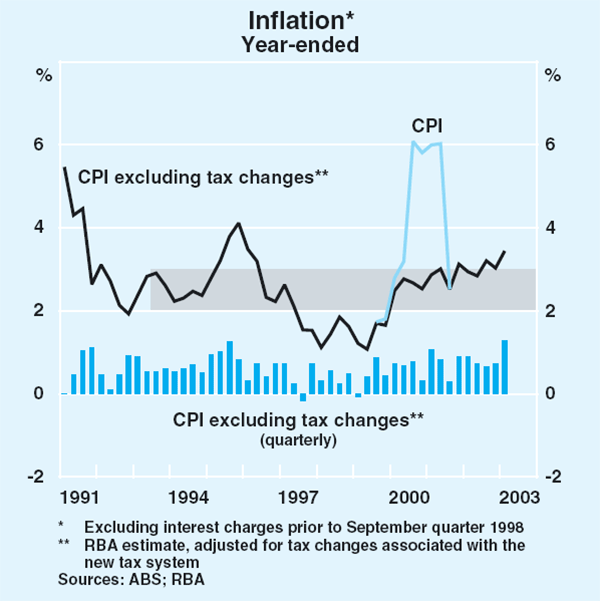
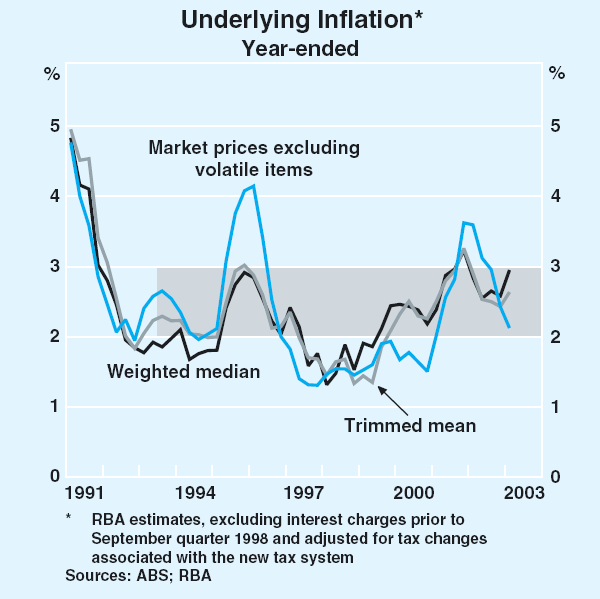
The largest contribution to the rise in the CPI in the quarter was made by fuel prices, which increased by 8½ per cent in the quarter and by 17½ per cent over the year. More recently, world oil prices have fallen back to their levels in late 2002, suggesting that much of the increase in fuel prices this quarter will be reversed in the June quarter. Higher vegetable prices also made a significant contribution to CPI inflation in the quarter, increasing by almost 12 per cent, primarily as a result of ongoing supply problems related to the drought. The prices of a range of other food items were also affected by the drought, including eggs, bread, cereals and lamb. House purchase costs, which have a large weight in the CPI, rose by 1½ per cent in the quarter and by 4¼ per cent over the year, reflecting rising construction costs as a result of the high level of housing activity. Rental prices, however, rose only slightly in aggregate and fell in Sydney and Darwin.
Several other categories of the CPI also recorded large price increases in the quarter: the price of pharmaceuticals increased by almost 12 per cent, in large part due to the seasonal operation of the Pharmaceutical Benefits Scheme; electricity prices increased by over 5 per cent, partly reflecting deregulation of the electricity industry in South Australia; and education prices rose by 4½ per cent.
Partly offsetting these increases, a number of categories recorded price falls in the quarter. Audio, visual and computing equipment prices continued their steady decline, falling by 4½ per cent in the quarter and by over 13 per cent over the year. In addition, there were broad-based price falls in clothing, footwear, furniture and household appliances, in part reflecting the influence of the exchange rate appreciation.
As noted above, differences between the various measures of underlying inflation can be explained in terms of the treatment of items that have experienced relatively large price movements in the quarter and over the year. The CPI excluding volatile items measure of underlying inflation excludes the influence of movements in fuel and fruit & vegetable prices, which made strong positive contributions to the CPI; this measure rose by around 2¾ per cent over the year to March. The market goods and services excluding volatile items measure, which is at the lower end of the range of measures, excludes these items plus a number of other items that experienced above-average price rises in the quarter, including pharmaceuticals, electricity and education. This measure appears to be understating inflationary pressures at present.
The statistical weighted median and trimmed mean measures exclude extreme price movements in both directions. When based on the distribution of quarterly price changes, these measures have recorded increases of 0.9 and 0.8 per cent in the quarter and 3 per cent and 2½ per cent, respectively, over the past year.
Producer prices
Producer price increases at all stages of production have picked up in year-ended terms, in part reflecting movements in oil prices (Graph 58). Excluding the effects of oil-related price movements, there was still a noticeable increase in upstream inflationary pressures in domestically produced items (Table 14). There were large increases in construction prices in the quarter, reflecting the ongoing strength in this sector, and relatedly, in the cost of real estate agent services. Other notable price increases in the quarter were recorded for major agricultural items such as beef, and for utilities such as electricity and gas.
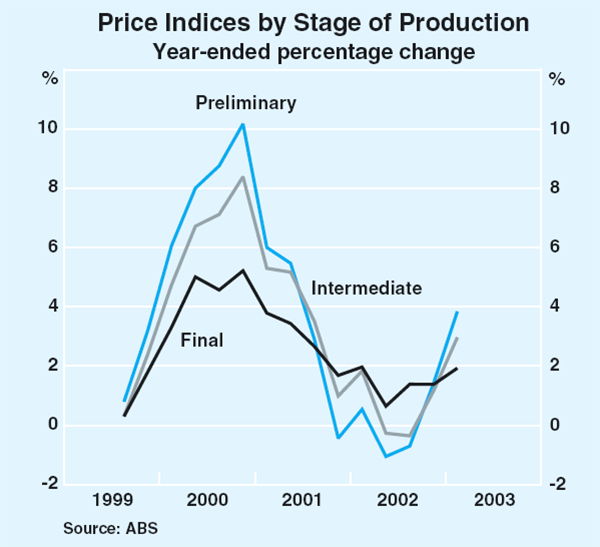
| March quarter 2003 |
Year to March quarter 2003 |
Year to December quarter 2002 |
|
|---|---|---|---|
| Preliminary | 1.1 | 3.8 | 1.4 |
| – Domestic | 1.4 | 4.2 | 2.1 |
| – Imported | −0.6 | 2.1 | −2.1 |
| – Excluding oil | 0.4 | 1.4 | 0.8 |
| Intermediate | 1.0 | 3.0 | 1.2 |
| – Domestic | 1.4 | 3.6 | 1.7 |
| – Imported | −1.3 | −0.8 | −3.0 |
| – Excluding oil | 0.5 | 1.3 | 0.6 |
| Final | 0.7 | 1.9 | 1.4 |
| – Domestic | 1.5 | 3.9 | 3.2 |
| – Imported | −2.5 | −6.3 | −6.1 |
| – Excluding oil | 0.5 | 1.3 | 1.0 |
|
Source: ABS |
|||
The increase in domestically sourced price pressures has been partly offset by price falls in a broad range of imported goods at all stages of production owing to the appreciation of the exchange rate. Large price falls were particularly noticeable for electronic equipment, reflecting the combined effects of the exchange rate appreciation and falling world prices for these commodities.
Indicators of upstream price pressures from business surveys remain moderate, but also have risen in recent quarters. The NAB survey reported that purchase costs increased by 0.6 per cent in the March quarter, having averaged 0.4 per cent in the previous four quarters. Expectations for the increase in purchase costs in the June quarter also rose to 0.5 per cent. The ACCI-Westpac survey reported that the net balance of manufacturing firms experiencing an increase in costs per unit of output also picked up for the second consecutive quarter, although it remains well below recent peaks.
Labour costs
Tighter labour market conditions over the past year have led to a slight pick-up in wage growth in recent quarters, although most labour cost indicators suggest that wage pressures generally remain contained. In the December quarter, the wage cost index (WCI) for total pay increased by 0.9 per cent in seasonally adjusted terms, to be 3.5 per cent higher than a year earlier (Graph 59). At the industry level, the WCI recorded the fastest annual wage growth in electricity, gas & water (4.6 per cent), and the slowest in communication services (3.0 per cent).
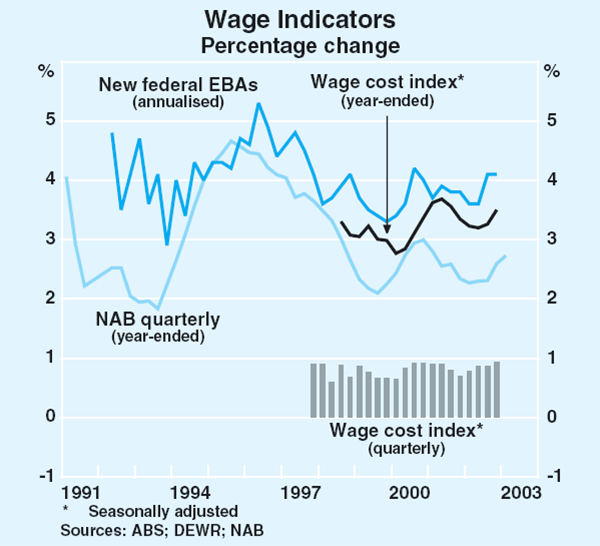
Business surveys also point to some increase in the pace of wage growth. According to the NAB survey measure, growth in total labour costs picked up over the year to March, and a broadly similar pace is expected in the next quarter. The NAB survey also reports that firms are having some difficulty in attracting suitable labour, although the ACCI-Westpac survey suggests that conditions are somewhat easier in the manufacturing sector.
Consistent with these developments, data from the Department of Employment and Workplace Relations indicate that the pace of wage growth in new enterprise bargaining agreements (EBAs) picked up in the second half of last year to 4.1 per cent. While part of the increase reflected a shift in the composition of new agreements from low-wage to high-wage industries, there appears to have been a slight increase in the underlying pace of new EBA wages over the past year. Wage increases for the stock of existing agreements remained at 3.8 per cent in the December quarter. The latest Mercer Quarterly Salary Review suggests that annual growth in executives' base salaries remained unchanged at 4 per cent in March.
The various wage bill measures continue to give divergent readings. Average weekly ordinary-time earnings of full-time adults (AWOTE) grew by 1.1 per cent in the December quarter, to be 4.8 per cent higher over the year. (For a discussion of the interpretation of wage-bill measures, see ‘Box B: Measures of Labour Costs’ in the August 2002 Statement on Monetary Policy.) The national accounts measure of compensation per employee grew by 0.5 per cent in the December quarter to be 3.2 per cent higher over the year. On a per hour basis, compensation grew by 0.6 per cent in the December quarter to be 3.5 per cent higher over the year, reflecting a decline in average hours worked. Unit labour costs (based on compensation per hour worked), increased by 1.1 per cent in the December quarter to be 2.8 per cent higher over the year.
In its Safety Net Review decision, announced on 6 May, the Australian Industrial Relations Commission granted a $17 per week increase in award rates up to and including $731.80 per week, and a $15 per week increase in higher award rates. Consequently, the federal minimum wage increased by 3.9 per cent to $448.40 per week.
Inflation expectations
Inflation expectations generally remain contained. According to the latest NAB quarterly survey, businesses continue to expect modest inflation in the near term; retail and other final product prices are expected to rise by 0.4 per cent in the June quarter (Graph 60). Having pointed to slightly higher inflation expectations since late last year, the most recent Melbourne Institute survey suggests that consumers have revised down their expectations to a level consistent with the average of their expectations over the inflation-targeting period.
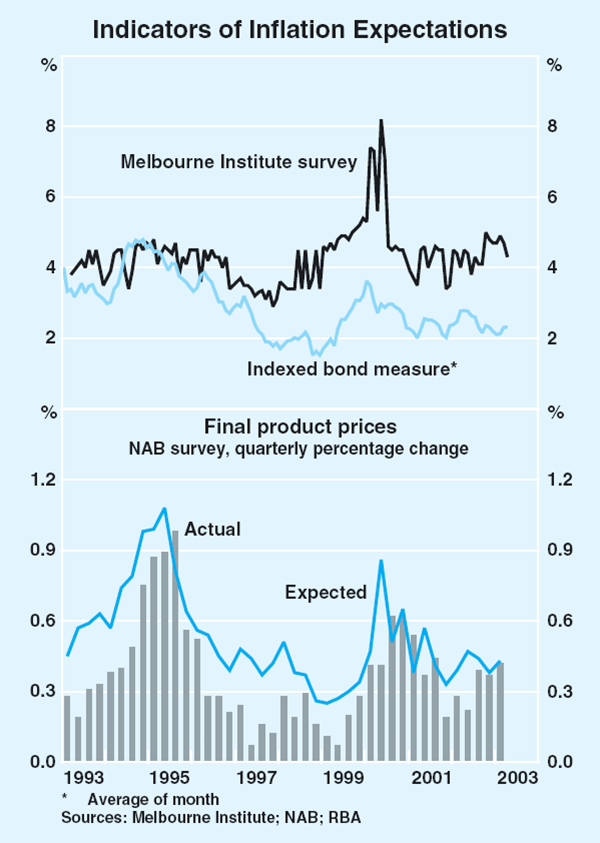
Longer-term inflation expectations of investors, measured by the difference between 10-year bond yields and indexed bonds, have been between 2 and 2½ per cent since August 2002. Financial market economists surveyed by the Bank after the March quarter CPI was released have revised their median inflation forecast for the year to June 2003, from 2.8 per cent to 3.2 per cent (Table 15). For the year to June 2004, their median forecast fell marginally to 2.3 per cent, partly reflecting expectations of a further appreciation in the Australian dollar. Trade union officials surveyed by the Australian Centre for Industrial Relations Research and Training (ACIRRT) have revised their near-term median inflation forecast up to 3.5 per cent and expect inflation to remain at this level over the year to June 2004.
| Year to June 2003 | Year to June 2004 | ||||||
|---|---|---|---|---|---|---|---|
| November 2002 |
February 2003 |
May 2003 |
November 2002 |
February 2003 |
May 2003 |
||
| Market economists(a) | 2.6 | 2.8 | 3.2 | 2.5 | 2.4 | 2.3 | |
| Union officials(b) | 3.5 | 3.3 | 3.5 | 3.4 | 4.0 | 3.5 | |
| (a) RBA survey (b) ACIRRT survey |
|||||||
Inflation outlook
The Bank's assessment is that underlying inflation was around 2¾ per cent over the year to March, and that it is likely to ease in the second half of 2003 to around 2½ per cent and remain around that rate over the following year. The difference between this expected path of underlying inflation and that reported in the previous Statement largely reflects the assessment that the March quarter CPI outcome indicated more inflationary pressures in the economy than had been anticipated, although these will be partly offset by the recent appreciation of the exchange rate. These projections are based on the assumptions that the exchange rate remains around current levels, and international oil prices remain around the middle of the OPEC target range.
This outlook is consistent with recent wage outcomes which, despite picking up in recent quarters, have remained moderate. Other cost pressures have increased modestly in the recent period. Producer price data and business surveys indicate that upstream price pressures have increased a little over the past couple of quarters. Inflationary pressures from rising oil prices and domestic sources, such as higher house purchase costs, have been present both in producer prices and in the CPI, although some of these pressures are expected to ease in the period ahead. The increases in domestic inflationary pressures have been offset to some extent by the disinflationary effects of an appreciating exchange rate and subdued world prices for items such as electronic equipment.
Much of the discrepancy between CPI inflation and underlying inflation over the year to March can be explained in terms of sharply higher oil prices. In the June quarter to date, oil prices have fallen back to levels seen at the end of last year, and consequently the recent effect of petrol price rises on the CPI is likely to be largely reversed in the June quarter. The drought-related increases in food prices such as vegetables, bread and cereals are also likely to be reversed to some extent over 2003 as rural production conditions improve. However, the breaking of the drought would also be likely to place upward pressure on the prices of some items; for example meat prices would be expected to rise as producers limited supply during herd rebuilding. Overall, with the influence of the drought and oil market developments abating, we expect that CPI inflation will align more closely with underlying inflation over the course of 2003.
The main source of uncertainty surrounding the outlook for inflation continues to be the outlook for world growth. The most significant piece of news over the past quarter bearing on the international outlook is that the near-term uncertainty associated with the conflict in Iraq has been largely resolved. This has been reflected in the fall in oil prices to well below US$30 per barrel, which is a positive development for world growth. Nonetheless, the prospects for the global economy remain subject to considerable uncertainty. If the global recovery were to fall short of current expectations, it would imply a weaker growth outlook in Australia and, consequently, weaker inflationary pressures.
The main upside risk to the inflation outlook would be if inflation expectations were to rise following the recent higher CPI outcomes: these have been at or above the target for a year now. At this stage, however, there is little sign of this occurring. While the Melbourne Institute survey of consumers had indicated some increase in inflation expectations in the early months of this year, they have returned to their average of the inflation targeting period in the latest survey, consistent with lower oil prices. Overall, the risks to the inflation forecast appear to be evenly balanced.
Footnote
For more information see ‘Housing Equity Withdrawal’, RBA Bulletin, February 2003, pp 50–54. [1]
Footnote Box A
OPEC member countries are Algeria, Indonesia, Iran, Iraq, Kuwait, Libya, Nigeria, Qatar, Saudi Arabia, the United Arab Emirates and Venezuela. [1]
Footnote Box C
See ‘Recent Developments in Housing: Prices, Finance and Investor Attitudes’, RBA Bulletin, July 2002, ‘Innovations in the Provision of Finance for Investor Housing’, RBA Bulletin, December 2002, ‘Housing Equity Withdrawal’, RBA Bulletin, February 2003, ‘Household Debt: What the Data Show’, RBA Bulletin, March 2003, and ‘Do Australian Households Borrow Too Much?’, RBA Bulletin, April 2003. [1]
Footnote Box D
An interest rate swap agreement can be used to convert a fixed-rate obligation into a floating-rate obligation (or vice versa). An issuer of a fixed-rate bond entering into an interest rate swap contract agrees to pay the floating Australian dollar interest rate to the swap counterparty on a regular basis (e.g. semi-annually). In return, the issuer receives the fixed swap rate, which is then used to pay the bond coupons. A cross-currency swap transforms the currency denomination of a debt obligation, for example from Australian dollars into US dollars. Analogous to the interest rate swap, the borrower makes regular payments of the US dollar floating interest rate and receives the Australian dollar floating interest rate. In addition, the Australian dollars obtained via the bond issue are exchanged for US dollars at the beginning of the agreement and re-exchanged at a pre-determined exchange rate at the expiry of the contract. [1]